#essays in love 1993
Note
Hello, in fic I've come across mentions of
- the elves stopping frequently on their journey to Aman to have sex (and Orome urging them forward by creating storms?)
- elf sex being too intense for most mortals to survive
I think these come from HoME or NoME (or similar sources), but I've never seen the actual quotes. There might be other things related to elf-sex in there as well.
So I guess my question is: What else did Tolkien mention about elf sex, apart from (the already relatively well-known) LaCE?
Elf Sex Lore
There comes a time in every Tolkien fan’s journey when they come upon the Professor’s writings on Elf sex — and, since 2021, there are even more! Elf Sex Lore remains a hot topic as the fandom continues to experience the aftershocks of the spurt of new lore that came with the publication of The Nature of Middle-earth (NoMe) in 2021.
As you say Anon, before NoMe was published, the fandom’s primary resource on Elf sex was the (in)famous essay Laws and Customs Among the Eldar (LaCE), published in 1993 in Morgoth’s Ring, the tenth volume of the History of Middle-earth series. LaCE is full of juicy (or not-so-juicy) lore about Elven aging, marriage, gender roles, naming, death, and rebirth.
It is in relation to the first two that we get some details on Elf sex, such as the knowledge that “it was the act of bodily union that achieved marriage, and after which the indissoluble bond was complete.” (Laws B). We also learn that:
“…the Eldar say* that in the begetting, and still more in the bearing of children, greater share and strength of their being, in mind and in body, goes forth than in the making of mortal children. For these reasons it came to pass that the Eldar brought forth few children; and also that their generation was in their youth or earlier life, unless strange and hard fates befell them. But at whatever age they married, their children were born within a short space of years after their wedding. For with regard to generation the power and the will are not among the Eldar distinguishable. Doubtless they would retain for many ages the power of generation, if the will and desire were not satisfied; but with the exercise of the power the desire soon ceases, and the mind turns to other things. The union of love is indeed to them great delight and joy, and the ‘days of children’, as they call them, remain in their memory as the most merry in life; but they have many other powers of body and of mind which their nature urges them to fulfil.”
The History of Middle-earth Vol. 10: Morgoth’s Ring, ‘The Later Quenta Silmarillion (II)’, Laws B
*Note how this paragraph is introduced: “the Eldar say”. Phrases like this signal to us that LaCE is not written from a Elvish point of view. There are indications elsewhere clearly pointing to a human author with a human audience in mind.
Translation: Elves use up a lot of energy in baby-making, including in the sex part (“begetting”) but even more in the pregnancy and birthing part (“bearing”), so they don’t have a lot of children and they do so early in life, shortly after marriage. But even if they marry later in life, Elves are still able to have babies because being able to and wanting to reproduce are the same thing for Elves. But once they’ve fulfilled the desire to make babies they’re good and turn to other things. Still, they look back on the time of baby-making as “the most merry in life”.
In most (if not all) cases, when Tolkien writes about sex he is writing about reproduction. Did Elves have sex solely for pleasure? Maybe; I cannot find anything that says they didn’t. I also can find little conceptual separation of sex and reproduction in Tolkien’s writings. Make of that what you will.
(At this point I want to reiterate a principle central to this blog: it’s about presenting what canon says; it is not about casting judgement on creations that subvert, reinterpret, or ignore canon, none of which makes a work lesser than one which adheres strictly to canon.)
So what did NoMe add to our knowledge about Elf sex? First of all, let’s make sure we all know what NoMe is.
What is The Nature of Middle-earth?
NoMe is a volume of texts by J.R.R. Tolkien collected and edited by Carl Hostetter. It is basically a supplement to the last three volumes of The History of Middle-earth (Morgoth’s Ring, The War of the Jewels, and The Peoples of Middle-earth), which cover a period from the late 1950s to his death during which Tolkien was undertaking a rather massive project of worldbuilding, working out the structures underlying his Silmarillion mythology in preparation for revising and publishing what he had written of it before ‘a sequel to The Hobbit’ (LotR) took him away from it for the better part of two decades.
Christopher Tolkien in Morgoth’s Ring called this undertaking “analytic speculation concerning [the] underlying postulates” of his world (Foreword to Morgoth’s Ring). That’s how we end up with essays like LaCE and the philosophical debate about the fates of Men and Elves in Athrabeth Finrod ah Andreth.
The texts in NoMe all date to around the same time and deal with the same sorts of questions about the physics and metaphysics of the world: it contains the essay on ósanwë, for example.
The Context of the NoMe Sex Lore
The first section of NoMe, ‘Time and Ageing’, is where we get the new lore on Elf sex. As it happens, the sex lore is rather incidental to extensive ruminations two core questions:
How did Elves experience the passage of time and how did they age?
How did the population of Elves go from 144 at Awaking to a sufficiently high number (around 30 000) when they reached the shores of Beleriand on the Great Journey?
(It is not relevant to get into why 144 and why 30 000 here; suffice to say those are the numbers Tolkien wanted and he expended great imaginative and mathematical energy trying to make them work.)
A note on the textual context: Anyone who has ever engaged in worldbuilding knows how it can go. You think (for example), “Okay, I need to develop a backstory for this character’s spouse,” and before you know it you are knee-deep in invented genealogies and geographies and Eru-knows-what-else.
It’s important to bear in mind that this is what Tolkien was doing. The quotes we are about to look at (yes, very soon!) are from a collection of evolving (and unresolved) notes in various states of refinement from barely legible scribbles to carefully penned essays. I will let you decide what that means to you based on your personal definition of canon, but I wanted the textual context to be clear.
Elf Sex Is Intense
In relation to Question 1, Tolkien considers the time-scales of Elven growth, including pregnancy. In the essay under discussion, Tolkien decides that Elven pregnancy should, like human pregnancy, take about 3/4 of a year. Oh no - not that kind of year. A yên, a ‘long year’, the unit used by the Elves and to which the matter of their bodies (their hröar) is bound. Elves gestate for 108 Sun years.
I know what you’re asking: If the pregnancy lasts 108 years, then how long does the sex last?
No? No! You’re probably asking yourself why Tolkien hated Elf-women so much (don’t worry, he says there’s no pain…)! But Tolkien was interested in the first question, which he answered thus:
“On the other hand the act of procreation, being of a will and desire shared and indeed controlled by the fëa, was achieved at the speed of other conscious and wilful acts of delight or of making. It was one of the acts of chief delight, in process and in memory, in an Elvish life, but its intensity alone provided its importance, not its time or length: it could not have been endured for a great length of time, without disastrous “expense.”” (NoMe, p. 24)
An earlier version of this passage, which you may also come across in fandom, comes to a similar conclusion:
“But the act of procreation not being one of growth until the union of the seed and being under full control of the will does not take long - though it is longer and of more intense delight in Elves than in Men: too intense to be long endured.” (NoMe, pg. 27)
Translation: Pregnancy, like other aspects of physical growth, is a process of the hröa over which the fëa has no control; thus it is bound to unfold on “Elvish time”, i.e. 1 year = 144 years. But the sex leading up to it is an act of the fëa and under its control and therefore occurs at a “normal” speed. The Elves love it, too! But not because of how long it lasts, which is a regular amount of time, but because of how intense it is. In fact, it is so intense that if it were any longer they would suffer “disastrous “expense”.”
What is this “expense”? Basically, it’s referring to the usage of an Elf’s natural “vitality” — far greater than that of Men but not infinite. As far as I can tell, this passage means that having intense Elf sex for too long would have spiritual results similar to Míriel’s bearing of Fëanor, or Fëanor’s creation of the Silmarils. Too much of their spirit would be expended (used up) in the act, with possibly disastrous consequences.
These are the quotes from which, I think, originate the rumour that Elf sex was too intense for mortals to survive. As you can see, the discussion is about Elf/Elf relations. Elf sex is too intense for Elves to endure for too long. Anything about what this means for Elf/Mortal sexual relations is fan conjecture.
That’s the Elf Sex nugget from Tolkien’s considerations of Elven growth rates: Elf sex (between Elves) is intense but of a normal duration.
Elven enthusiasm for baby-making delays March
As you can imagine, more nuggets are unearthed in relation to Question 2, which boils down to Tolkien crying: “I need the Cuiviénen Elves to breed a lot and quickly!”
Initially, Tolkien developed some Elven life cycle schemes that had them taking a leisurely approach to reproduction, with each generation taking many hundreds, even thousands, of Sun years to materialise.
This scheme did not work for getting him from 144 to ~30k in the timeframe he wanted. So, he made some adjustments to the scheme with respect to the timing of Elven maturity and consequent desire to begin reproducing — and then set about getting those Elves procreating!
One of the solutions he entertained was giving the Elves opportunities to reproduce on the Great Journey. He laid all of this out in a timeline (NoME, p. 49-53) detailing where and for how long the host of Elves would pause because of the “desire to beget children” (p. 49).
Reading this timeline, it can become increasingly comical each time this desire to reproduce (i.e., have sex) halts the host. It can start to read like, “The Elves took forever to cross Middle-earth because they couldn’t stop banging!” And, in a way, that is what happened. But bear in mind the context is an attempt at solving the problem of increasing the Elven population to a number Tolkien considered satisfactory for his worldbuilding endeavours. An Elven enthusiasm for sex is there, but it’s not the whole picture.
There are several points on the timeline when Oromë hangs out with the Elves or checks in on them, and he does become increasingly concerned with their begetting-related delays. For example:
“About 2000 pairs (of available Telerin 8th gen. of 4,950) beget children in the spring 1130/80. The Chiefs and Oromë are disturbed.” (NoMe, p. 51)
(“The Chiefs” are Ingwë, Finwë, and Elwë.)
And:
“Either by chance, machinations of Sauron, and/or because Oromë withdraws protection (hoping to make the Eldar less content with their new Home (Atyamar), winters are hard and the weather worsens.” (NoMe, p. 51)
The second quote is the origin of that rumour about Oromë creating storms to urge the Elves on because they were having too much sex. Is it canon? Not quite: Oromë didn’t create the storm, for one, and the emphasis is on sex for the pleasure of children more than the pleasure of sex on its own (though, as we know from the previous discussion, sexual pleasure was certainly had!). But the rumour you've heard is not without basis in Tolkien’s notes.
The First Elves Really Loved Sex
There’s one more Elf sex nugget in NoMe that I’d like to end with. While scrambling to get his Cuiviénen Elves reproducing at an adequate rate to reach his population-at-finding target, Tolkien came up with what he calls the “Quick prolific” scheme (p. 99).
“The Quendi in their first few generations before the March (or reaching Valinor) must — as is quite reasonable — be made far more eager for love and the begetting and bearing of children. *They must have larger families, at shorter intervals between births.” (p. 107)
To explain this attitude of reproductive eagerness in the first few generations of Elves, Tolkien coins the term “philoprogenitive” — they love to procreate! Procreating — not artistic and intellectual pursuits or exploration or leadership as with later generations — is their number one priority in life. So much so that “they mated almost at once with their predestined mates” (p. 54).
Not only that, but they have so many babies! In one version of the scheme, 12 children per couple in the first generation (p. 108). (This soon changes to 6 per couple. Philoprogenitive they may be, but no one gets to outdo Fëanor).
As with the highly intense Elf sex and the Great Journey delayed by procreating, this is another bit of NoMe lore with great imaginative potential. As we learn from LaCE, Elves enjoyed sex, quite a bit actually, but they enjoyed a lot of other things also, and after a period of baby-making they would usually move on from sex (though they would always remember it fondly). But the First Elves, those early generations by the shores of Cuiviénen? No such balance between sex and other pursuits. It was all about sex and procreation for them.
Of course, what we’ve been looking at are drafts and notes. While all written around the same time (late 1950s to early 1960s), none of the texts here examined were ever finalised and many of them don’t even agree with each other. Tolkien was experimenting; he was worldbuilding. And with the publication of these notes in NoMe, we in turn get some intriguing ingredients for worldbuilding of our own.
So, do as you like with the Elf sex lore. But if you’re looking for a great setting for some canon-compliant smut, may I suggest Cuiviénen?
Resources
PDF of LaCE
Mythgard Academy’s seminars on The Nature of Middle-earth. You don’t actually have to have read or own NoMe to follow these discussions. Great for getting a handle on the material, and ideal for listening as you work your way through reading.
#nature of middle-earth#history of middle-earth#laws and customs among the eldar#anon#happy valentine's day
189 notes
·
View notes
Text
I'll Love You 'til the Grass Around My Gravestone is Deceased
harry potter timeline sirius black x fem!reader
CHAPTER TEN (see full series list here)

1993
"Now, the mean temperature on Venus is four-hundred and sixty-two degrees celsius, making it hotter than Mercury, despite it being further from the Sun. Can anyone tell me why?"
Your third-years look around the room at each other uncertainly. You have them sitting down at desks as you teach some theory to them.
"Is it just...'cause it is?" Ron guesses, and Harry snorts beside him, earning a dirty look off Ron.
"A perfectly vague answer, Mr Weasley," you reply. "You should consider becoming a politician."
You glance expectedly at Hermione, who has fallen asleep, head held up by her right hand. Lavender Brown pokes her and Hermione wakes with a start, blurting out, "G — greenhouse effect!"
You nod, turning back to your whiteboard. "Yes...the greenhouse effect. There's an incredibly high concentration of carbon dioxide in Venus' atmosphere, which produces the greenhouse effect. All the heat gets trapped in the atmosphere, like a blanket, and makes it unbearably hot." You glance back at Hermione again, adding, "Ms Granger, please see me after class."
You continue on and later, when the class ends and the last of the students are filtering out, Hermione approaches your desk nervously.
"Professor, please, I didn't mean to fall asleep! Please don't be angry I didn't — "
"Hermione," you say gently, gesturing to the seat in front of your desk. "Sit, please. I'm not angry with you at all, relax."
Hermione relaxes slightly, taking the seat in front of you.
"How many classes are you taking, Hermione?"
She bites her lip. "Thirteen, Professor."
You're quite taken aback at this. "Thirteen?"
"Y — yes, Professor."
You sigh. "Hermione, your workload is far too much for a young girl to handle. Far too much for anyone to handle! It's not good for you — how are you even getting to all these classes on time?"
"My — um, my timetable was fixed by Professor McGonagall..."
You shake your head. "Please, Hermione. All this is clearly taking a toll on your health. Why, the last essay you turned into me was about Arithmancy."
Hermione's eyes go wide. "Oh, no! That means I gave Professor Vector my Astronomy one, oh my goodness — she's going to be so mad with me."
"I'll talk to her," you say reassuringly. "For now, Hermione, I want to see you go straight back to your dorm and sleep. And you are not to attend your next Astronomy class."
"But, Professor — "
"Hermione," you say sternly. "I don't want to see you in my next class. You won't miss anything important, I promise. I want you to use that time to rest, please. Now, straight to bed with you."
"Professor..."
"Goodnight, Ms Granger," you say and she reluctantly stands. "And if you ever need anything, don't hesitate to tell me. Anything at all. I'd be happy to help."
Hermione gives you a small, tired smile. "Thank you, Professor."
"Goodnight."
✧*。✧*。
On a Saturday, when most of the students have gone to Hogsmeade, you sit in Remus' office, drinking tea and snacking on a few cupcakes Bitsy made you.
"How's the potion treating you?" You ask casually, taking a bite out of another sweet cupcake.
Remus grimaces, eyeing the empty goblet on the corner of his desk. "It's rancid. But it works, so I shan't complain."
"What's even in it?"
"Well, Wolfsbane, of course..moonseed, dittany — "
You gag. "Gross."
He hums. "Exactly."
"Lupin! I want a word!" Comes the voice of Snape from Remus' fireplace suddenly, along with his angry face. "And bring her with you!"
You glance at Remus in confusion and he just shrugs, before you both step into the fireplace and clamber out of the other end in Snape's office. You brush ash off your jumper, scowling at Snape and then noticing Harry.
"You called, Severus?" Remus says mildly.
"I certainly did," Snape says, face contorted in fury as he returns to his desk. "I have just asked Potter to empty his pockets. He was carrying this."
He points at a piece of parchment in front of him, laid flat on the desk. Inked upon it, were four sentences:
Mr Moony presents his compliments to Professor Snape, and begs him to keep his abnormally large nose out of other people's business.
Mr Prongs agrees with Mr Moony, and would like to add that Professor Snape is an ugly git.
Mr Padfoot would like to register his astonishment that an idiot like that ever became a Professor.
Mr Wormtail bids Professor Snape good day, and advises him to wash his hair, the slimeball.
Well, fuck.
You do your best not to laugh and keep your expression as blank as possible. Those boys, no matter what, will always find a way to send Snape an 'up yours' in some shape or form.
"Well?" says Snape, scowling.
You stare at the parchment, mind running. "This seems to be a very...childish slip of parchment."
"Childish?" Snape repeats. "This parchment is plainly full of Dark Magic. This is supposed to be your area of expertise, Lupin. Where do you imagine Potter got such a thing?"
Remus sends you the tiniest, near-imperceptible glance and you look straight ahead, boring holes into the parchment.
"Full of Dark Magic?" he says mildly. "Do you really think so, Severus? It looks to me as though it is merely a piece of parchment that insults anybody who tries to read it. Childish, but surely not dangerous? I imagine Harry got it from a joke-shop — "
"Indeed?" Snape's jaw is rigid with anger. "You don't think a joke-shop could supply him with such a thing? You don't think it more likely that he got it directly from the manufacturers?"
You cough lightly. "Hardly. Harry, surely you wouldn't be too keen to take something from someone named Wormtail, would you?"
"No," Harry says quickly.
"You see, Severus?" says Remus. "It looks like a Zonko's product to me — "
As if he was waiting for his moment outside the door the entire time, Ron Weasley bursts through Snape's door, red-faced and breathless.
"I — gave — Harry — that — stuff," he wheezes. "Bought — it — in — Zonko's — ages — ago..."
"Well!" Remus says cheerfully, clapping his hands together and giving you a happy grin. "That seems to clear that up! Severus, I'll take this back, shall I?" He grabs the map, folding it up and tucking it inside his robes. "Harry, Ron, come with me. I need a word about my vampire essay."
"Oh, I also need to discuss your star charts!" You blurt out, smiling at the two young boys.
"Excuse us, Severus," Remus says, and the four of you leave the office and walk in silence all the way back into the Entrance Hall before speaking.
Harry glances nervously between the two of you, starting, "I — "
"I don't want to hear explanations," Remus says shortly. He glances around the empty Entrance Hall, lowering his voice. "I happen to know that this map was confiscated by Mr Filch many years ago. Yes, I know it's a map," he says, and you take in Harry and Ron's amazed faces.
"I don't want to know how it fell into your possession," he continues. "I am, however, astounded that you didn't hand it in. Particularly after what happened the last time a student left information about the castle lying around. And I can't let you have it back, Harry."
"Why did Snape think I'd got it from the manufacturers?" Harry questions.
Remus hesitates. "Because — um..."
"They're a bunch of gits who'd have loved to put you in danger," you finish.
Remus frowns at you and you shrug.
"Do you know them?" Harry says, seeming impressed.
"We've met," Remus tells him curtly. He's got that extremely serious Remus expression on his face that he used to get during exam season, when he'd act like he wanted to study but really he didn't.
"Don't expect us to cover for you again, Harry," he says sternly. "I cannot make you take Sirius Black seriously."
If it wasn't for his grave tone, you would laugh at that.
"But I would have thought that what you have heard when the Dementors draw near you would have had more of an effect on you. Your parents gave their lives to keep you alive, Harry. A poor way to repay them — gambling their sacrifice for a bag of magic tricks."
You're surprised at his last words, but can barely comment on them because he's spun on his heel and headed in the opposite direction. You catch up to him as he enters his office, throwing the map down on his desk with a sigh.
"Jeez, Moony, that was a bit harsh," you mutter and he nods grimly.
"I know, I know...but it's the only way to make him realise the severity of this situation."
You stare idly at the folded parchment on his desk. "So, what, Harry nicked the map from Filch's?"
"I suppose so," Remus answers. "We are lucky to have caught it."
"And, Merlin, that charm...Snape looked like he wanted to rip your head off."
"I'm aware. I...I don't remember writing that," he says abashedly.
You chuckle. "It was brilliant. Absolutely bloody brilliant."
✧*。✧*。
It's not long before the Quidditch Cup Final arrives, and the tensions are high in the castle between Gryffindor and Slytherin. There's been more than one occasion where you've had to break up scraps between students, deducting a few points from each house.
The match falls on a beautifully sunny day and you sit in the stands, watching the Gryffindor team elatedly dance around in celebration, hoisting the Cup into the air enthusiastically. They're all smiles and happy faces and it warms your heart to see.
It reminds you of the time Gryffindor won the Quidditch Cup during your sixth year at Hogwarts.
♡*。♡*。
You clutch the megaphone in your hand tightly, leaning forward to watch the match.
1997
"GRYFFINDOR'S RYDER IN POSSESSION AND SHE'S GONE!" you cry. "SHE'S BOMBED THROUGH THE AIR AND OH, HERE COMES LEVINSON FOR THE CHALLENGE...PASS TO BURNS, BURNS SHOOTS...SCORE! TEN-ZERO TO GRYFFINDOR!"
The Gryffindor side of the stands erupts into cheers and Burns grins proudly. You spot James Potter ambling around the air on his broomstick, his eyes dancing around the pitch in search of the Golden Snitch. Slytherin's Seeker, Regulus Black, is watching James closely, waiting for any slight movement to indicate that he's seen it.
"SLYTHERIN IN POSSESSION AND IT'S MALFOY..." you gag dramatically, earning a glare from Professor McGonagall beside you. "MALFOY PASSES TO LEVINSON...LEVINSON TO PHILLIPS, PHILLIPS JUST BARELY DODGES A WELL-PLACED BLUDGER FROM GRYFFINDOR'S BLACK...he's quite handsome too — "
"Focus on the game!"
"Right, yeah — got it, Professor!" you grin at her and she sighs. You glance down at Sirius, who sends a wink in your direction and you blow a kiss back.
Then, movement on the side of the pitch catches your eye: Slytherin Captain, Lynx Phillips, has just punched Gryffindor Captain, Ryan Carr, who launches his Beater's Bat right back at him, clocking him in the jaw. Madam Hooch blows her whistle furiously and zooms over to them, an enraged look on her face.
"PENALTY, PROFESSOR! THAT'S A PENALTY RIGHT THERE!"
"Penalty to Gryffindor for an unprovoked attack on their Beater! Penalty to Slytherin for an attack on their chaser!"
Ryder flies up to the Slytherin goal to take a shot.
"COME ON, RINA...YES! SHE SCORES! TWENTY-ZERO TO GRYFFINDOR!"
Next, Levinson comes to take the Slytherin penalty, scowling at Gryffindor's Keeper, Fleming.
"FLEMING'LL SAVE THIS ONE, NO DOUBT...WELL, OKAY, MALFOY CLEARLY SABOTAGED THAT ONE. TWENTY-TEN TO GRYFFINDOR!"
Time passes, scores ticking up on both sides. Everyone is on the edge of their seats, waiting in anticipation for each blow.
"HERE GOES PHILLIPS WITH THE QUAFFLE...HIT BY GRYFFINDOR BEATER SIRIUS BLACK ONCE AGAIN! YAXLEY DROPS THE QUAFFLE AND IT'S INTERCEPTED BY RYDER AND SHE'S GONE — WAIT, WHERE THE FUCK DID SHE GO? I'M AFTER LOSING HER — AND SHE SCORES! ONE-HUNDRED- EIGHTY TO GRYFFINDOR!"
"Language!"
"YEAH, SORRY, PROFESSOR...BUT IT LOOKS LIKE GRYFFINDOR SEEKER, JAMES POTTER, HAS SPOTTED THE SNITCH! SLYTHERIN'S BLACK IS TRAILING CLOSE BEHIND..."
James bolts through the air, heading towards the Gryffindor goals where he's spotted the Snitch. Regulus is barely an inch behind him, hot in his heels.
"FASTER, JAMES, HE'S RIGHT BEHIND YOU!"
Finally, James is upon the Snitch and he clasps it in his right hand and raises it triumphantly. The crowd explodes. Gryffindor flags are waved like mad and McGonagall cheers excitedly beside you.
"WOO! JAMES POTTER HAS CAUGHT THE SNITCH, ENDING THE GAME TWO-HUNDRED AND FIFTY TO NINETY AND WINNING GRYFFINDOR THE QUIDDITCH CUP!"
The Gryffindors collide with each other mid-air, and you watch as Sirius and James throw their arms around each other, landing quickly and jumping up and down elatedly. You quickly drop the megaphone, jumping out of your seat and running down the stairs towards the pitch. You sprint out along with all the other Gryffindor supporters.
Everyone is cheering and shouting in the middle of the pitch and you stop just beside Sirius. He notices you and beams, his handsome face lighting up, and he detangles himself from James to throw his arms around you. You kiss him and he lifts you up to spin you around, making you giggle in delight. Eventually he sets you down.
"You were brilliant!" You exclaim. "You did so well, Siri — "
He kisses you again, and you can feel him smile against your lips. You pull away and grin at each other, before finally you let go of him and hug James.
"Not too bad, Potter!" You say with a laugh, ruffling his hair good-naturedly.
"We won the Cup!" He shouts happily, unable to quench the huge grin stretching his face.
"We won the Cup!" You repeat, grinning just as enthusiastically back at him.
You hug everyone in sight, giving Remus, Peter, Alice, and Lily especially tight ones and by the end of it you're bouncing on your toes in happiness.
It can't get any better than this, can it?
♡*。♡*。
Exam season starts and there's a hush around the castle. You watch as your third-years filter into the Astronomy Tower looking especially nervous. Hermione Granger has her eyes closed and is reciting the names of Saturn's moons to herself — somehow managing to remember all one-hundred and forty-six. You're amazed at that really, but feel bad because she only needed to know one.
"Okay, everyone. Please take a seat and start filling out the papers in front of you. There's four questions on it. When you've finished, go to a telescope and I'll give you three constellations to chart. Best of luck everyone!"
The students sit down at the desks, and start filling out the papers in front of them. After a minute, Ron Weasley is already scratching his head at the first question; Hermione Granger has already managed to reach the end of the parchment; and Harry Potter is just blankly staring at it.
Later, Hermione springs out of her chair and you ask her for three constellations, which she charts very neatly and accurately.
It's not long before their time is up and they all leave the Tower, and you're stuck with a stack of parchment to work through.
✧*。✧*。
->-> read chapter eleven here!
→ all kinds of interaction are appreciated ♡
+ thank you especially to my new taglist loves:
@wholelottalove05 @izuoyarmin
#sirius black x reader#sirius black#sirius black x you#angst#fanfiction#angst with a happy ending#the marauders#harry potter#hp#fanfic#marauders#hp fandom#hp fanfic
88 notes
·
View notes
Text
Timeline: Part 9 - December 1-10 2017
For earlier timeline posts: click here or here.
December starts out strong with a daily bombardment of tons of stories about Meghan and/or Harry. Their PR backs off in the middle of the month, but only barely. Luckily for us, there is salvation: Meghan gets her first, second, third, and fourth dose of royal criticism.
Like I mentioned in the November 2017 timeline, this month sees Meghan pulling her support from Star Magazine, US Weekly, and E Online. People Magazine begins to earn her loyalty instead.
Ok, apparently I exceeded the limit of links that can be in a Tumblr post. the December edition is going to be split up into smaller segments. I've got a solution for how to fix this going forward, but it's going to take some time to figure out how to implement it.
12/1/2017: Fleet Street has a fever and the solution is more Harkle coverage.
Doria is papped at a laundromat in California.
Another story about Ninaki's photos of Meghan.
Can Kate cope with Meghan Mania?
Harry and Meghan make their first appearance together at a royal engagement.
Meghan and Pippa look alike.
Meghan and Harry's engagement is straight from Love Actually.
Meghan's old men's magazine photoshoot resurfaces.
Replica of Meghan's ring is an instant bestseller.
Meghan merches her outfit.
Meghan's 1993 Nick at Nite appearance reserfaces.
Meghan is Best Dressed of the Week.
Meghan's resume will seriously surprise us.
Anything Kate can do, Meghan can do better: First Royal Engagement edition.
Meghan's royal style vs her old Suits style.
Meghan leaks intent to visit US and Canada after the wedding in her first official foreign royal tour.
12/2/2017: Meghan's "draw your own box" essay goes viral again, as does her old Larry King Show interview. The Markles sell more pictures of Meghan, Meghan once tried to hook up with Ashley Cole but failed, and she makes a dig at William and Kate with a story about her and Harry holding hands.
12/3/2017: Meghan merches the Botswana camp again. The Times writes about Meghan's old instagram account and Bogart and leads speculation about bridesmaids and pageboys. Et tu, Times?!
Note: December 2 is a Saturday and December 3 is a Sunday. How nice Meghan's PR gave us a break for the weekend. But don't worry...the bombardment is back!
12/4/2017: Harkle Mania continues
About Meghan's ring
Meghan once auditioned for Shakira
All about Thomas Markle
Meghan leaks her expectations of marital bliss.
Meghan leaks that Harry has asked William to his best man. (Note, in Spare, Harry argues that this leak came from Kensington Palace but the source is US Weekly...Meghan's magazine.)
Wedding dress designer predictions
Meghan Markle Under Fire: Why is the Future Princess the Subject of So Much Scrutiny? (From E News, a Meghan affiliate)
Let the Misogynistic Public Shaming of Meghan Markle Now Commence (From Vogue, part of the CondeNast empire, to which People Magazine also belongs...Meghan affiliate)
Meghan Markle the garden influencer
Meghan's photoshoot charity work in Rwanda resurfaces.
What's with Prince Harry, Meghan Markle, and Bananas? (I kid you not, that's the title of the article.)
Will Meghan's wedding be like Pippas?
Meghan and Harry love bananas some more - they merch a banana cake.
12/5/2017: New day, same shit. Senior royals attend the Diplomatic Reception at Buckingham Palace but Meghan and Harry skip it to attend the Henry van Straubenzee Memorial Fund carol concert (pssh...like they were even invited to the Diplomatic Reception in the first place).
Daily Mail promotes Suits
Meghan's style inspiration is Carolyn Bessette-Kennedy.
Meghan merches clothes from when she was a teenager.
Harry appears on Top Gear.
Meet Meghan's celebrity doppelganger.
Meghan wants to wear the Spencer tiara for the wedding.
Meghan merches her engagement ring again.
Meghan the beauty icon.
12/6/2017: (le sigh...)
Who does Meghan curtsey to?
Meghan manifests The Lover's Knots Tiara for the wedding.
Nobody told Meghan she was pretty as a kid. (But did they ask her if she was OK?)
Meghan leaks about Ninaki's betrayal.
Harry attends the London Fire Brigade Carol Service alone, and so does his ex, Cressida. Meghan is upset and leaks that she is in LA visiting her mother.
Meghan merches Strathberry.
Can Meghan rewrite the royal fairytale?
Meghan the fashion influencer
12/7/2017: Another story about Misha Nonoo being the royal matchmaker. Thomas Markle does a papwalk. Meghan merches a pilates workout and is "incredibly moved" by how much people love her.
12/8/2017: The Crown Season 2 is released on Netflix
Meghan's old home video of her driving around LA resurfaces.
How Meghan won over Harry's friends.
Doria gets papped in LA.
Meghan leaks that she and Harry are staying with William and Kate at Anmer Hall for Sandringham Christmas.
Meghan leaks that William is planning Harry's stag party.
Meghan manifests for Selena Gomez to play her on The Crown.
World Vision promotes Meghan's charity work again.
All about Nottingham Cottage and Meghan's interior design style
Kate takes style inspiration from Meghan
12/9/2017: Meghan merches her Toronto rental. Harry quits smoking.
12/10/2017:
Meghan's old Tig article waxing poetic on Ivanka Trump resurfaces.
Harry goes to Germany with friends for a hunting party.
Doria does a papwalk.
Kensington Palace announces that Meghan will attend Sandringham Christmas and that she is expected to attend the Windsor Christmas luncheon at Buckingham Palace.
Old photos from a 2009 TV appearance Meghan did resurface.
William and Harry choose a sculptor for Diana's Kensington Palace statue.
Meghan hailed as a royal fashion asset.
34 notes
·
View notes
Text
Essay on the relationship between goth and grunge
Goth is a music based subculture created in the 80s. Pioneered by bands such as Bauhaus, Siouxsie and the Banshees and The Cure, it is a subculture with a convoluted history and tumultuous developments. Its aesthetic, sonic and lifestyle components being influenced primarily by horror films, avant garde art, music, cinema and literature, campy b movies, glam rock, punk, old Hollywood and classic literature, it has been among the most surviving counterculture amongst others of the same era, especially among teens and adults. It has survived, and continues to struggle against, numerous misconceptions and stereotypes by the media, perverted men and posers deliberately warping the scene to their advantage due to the efforts of those among the scene. It has clearly defined values and characteristics of those who choose to participate in the scene, that revolve around clubbing, social participation, seeing and being seen, political and cultural conscientiousness, creativity, insular tastes in media and hobbies and overall can be seen as a means of self help and building of one’s identity.
Grunge, on the other hand, at first seems the radical opposite.
Grunge, also a music based subculture, was created in Seattle in the 90s, although there is evidence to support that grunge type sounds have been around prior to the 90s in the form of bands such as Flipper and Green River. Nevertheless, grunge was popularized by bands such as Nirvana, Pearl Jam, Soundgarden and Alice In Chains, becoming huge throughout the beginning to the middle of the decade. Amongst the members of Gen X who participated in the scene, the unfashion and sonic elements of grunge was influenced by feelings of directionless and lack of hope for the future, as the workforce at the time was still dominated by boomers who refused to leave space for Gen X. These historical components can be seen the deliberately slovenly fashion of grunge adherents in the form of flannel shirts, t shirts and ripped jeans, many Nirvana lyrics being purposely directionless to represent such feelings by Kurt Cobain, and an overall reclaiming of the stigma of poverty to combat the material excessiveness of the 80s. Grunge, as a sound, varies from the punk sounds of Mudhoney, alternative rock such as Nirvana, sludgy metal in the form of The Melvins, Soundgarden and Alice In Chains to an evenly sounded Mother Love Bone, but can be best described as a mix between Punk and Metal.
According to many goths and punks around at grunge’s rise to popularity, grunge was an especially disliked scene, due to the punks feelings of many grunge kids being the same individuals who bullied and ostracized the alternative crowd of the 80s, and would have done the same to Kurt Cobain had he never became famous, along with many goths and punks disliking the toxic masculinity displayed by grunge adherents in fashion and behavior, especially in regards to many hair metal bands going in a grunge direction.
Grunge has been documented and dissected, much to the dismay of those involved, since the beginning. The most famous example of this phenomenon is Marc Jacobs Perry Ellis fashion “grunge” runway of 1992-1993, reportedly so disliked it was burned by Kurt Cobain and Courtney Love, along with causing Jacobs to be fired by Perry Ellis, due to an increasing concern of the commercialization of grunge that it never really recovered from to this day, another stark contrast it has from goth. If you look up grunge now on the internet, you will find a warped idea of grunge in the form of expensive fast fashion brands and clothing, Instagram accounts featuring hyper sexualized depictions of vaguely alternative women and the remaining devotees of true grunge culture in the form of old men and young people alike on the internet posting of bands like Nirvana.
At first glance, especially looking at the masculine sides of grunge, that goth and grunge are inherently incompatible, and due to grunge’s popularity eating at the goth scenes previous dominance in youth culture of yesteryear. But, I would like to offer a different argument from an angle no one has quite considered. The feminine elements of grunge.
Kinderwhore, is a variant of grunge fashion worn by women in grunge bands and within grunge scenes that was created by Kat Bjelland of Babes in Toyland and popularized by Courtney Love.
Where exactly Kinderwhore gets its name is from journalist Everett True, during an interview with Kurt Cobain and Courtney love. The fashion revolves around purposely inflating traditional, girlish fashions to cartoonish levels, and then subverting them via aggressive, masculine behavior to avoid potential insecurities. Meaning, many women in grunge bands who dressed kinderwhore would always be as aggressive on stage as the men, oftentimes singing feminist lyrics.
The fashion itself revolves around babydoll dresses, slip dresses and Mary janes or combat boots, along with ripped tights, chokers, leather jackets, cardigans and dresses with lace details or Peter Pan collars.
Kinderwhore is related to riot grrl, which is a subset of punk that was underground in the 90s in contrast to grunge, but some within the grunge scene, especially Courtney Love, rejected and denied her work being riot grrl in the first place. If one sees riot grrls middle class origins, white feminism, exclusionary behavior towards trans women, and superficial lyrical and social attitudes, it’s easy to see why many within punk and grunge scenes would want to distance themselves from it. That being said, riot grrls only contribution worth noting to punk was it’s push towards inclusiveness to women due to punk growing increasingly misogynistic and unsafe for women in the 80s, and its efforts have done the most to make punk a better space for women.
What attracts many goths to goth fashion is a deliberate subversion of gender and gender roles in the form of its visuals. Many goths, men and women, would both wear makeup and dress masculine or feminine as they desired, especially due to goth’s acceptance of those deemed “different” by broader society. With keeping in mind to Kinderwhore, a fashion style that also revolves around subverting gender expectations, it is to be expected that among women of goth and grunge, a meeting was destined to take place. Among the women of 90s goth, it was common for them to combine goth fashion with kinderwhore looks.
In the 90s new wave bands such as Strawberry Switchblade, and deathrock bands such as Cinema Strange have experimented with Kindergoth (kinderwhore + goth) looks, that ultimately led designers such as Anna Sui sending her team to scout goth clubs to take inspiration for designs for future garments that would oftentimes be out of reach for many goths due to lack of affordability for the working class individuals in the scene.
With all these examples in terms of visuals, goth and grunge inspired looks is a feasible venture provided it is put under feminine lenses. Many attempts have been made by those who understand neither scene to create a “grunge goth” hybrid, as seen in many online accounts and opportunistic business ventures by outsiders, but a true grunge goth fusion would combine goth fashion with the ever subversive kinderwhore fashion, its legacy seen in many online aesthetics including the Morute aesthetic, a sister aesthetic subculture used primarily as a means of coping with childhood trauma via the means of girlish femininity combined with grunge and American gothic encapsulated by the works of Nicole Dollanganger and an assortment of women photographers on tumblr and beyond.
Sonically, there can be a case for similarities between goth and grunge. Both use a distorted bass, use vocals that howl and scream and punk like guitars. With these similarities in mind, I believe it is feasible for a grunge/deathrock hybrid band to exist, but as of this writing I cannot find a band that has done this. Perhaps some day.
Sources:
Some wear leather some wear lace by Andi Harriman
https://youtu.be/peEUXhCY8lY by Angela Benedict and the comments cited
My dad, a true grunger :)
Various accounts from old punks on Reddit on r/punk
Marc Jacobs’s Perry Ellis Grunge Show: The Collection That Sent a Electric Shock Through '90s Fashion | Vogue

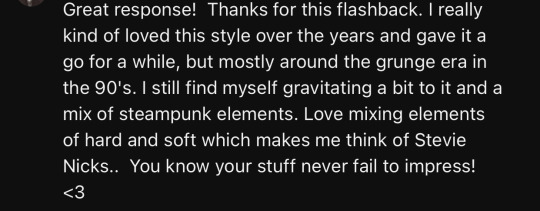


#mine#my essays#new year new motivation to actually post essays#essay#gothgoth#90s grunge#grunge#kinderwhore#morute#goth music#goth fashion#grunge fashion#cultural studies#feminism#anarchopunk#punk culture#punk#kindergoth#fashion history#90s fashion#alternative fashion#music history#grunge music
322 notes
·
View notes
Note
https://olderthannetfic.tumblr.com/post/732332511005458432/so-the-straight-with-one-exception-shit-that-was#notes
Yeah, I don't get why this is a big mystery why this is. People were a lot more clueless about sexuality in the past + it felt like a much bigger idea to specifically identify yourself or your favorite character as Gay back then. It was a politicized identity, it was something that people associated with people fighting for rights and politicians railing against on TV. And I mean that still happens but I think that in a lot of places, being LGBTQ+ has become so normalized and everyday that people don't see identifying that way as having as much baggage as they did in the 1990s and 2000s.
Also, I really think that a lot of us who identify as some variety of LGBTQ+ and have social circles that are full of LGBTQ+ people and allies and spend a lot of time online can really forget how many people are still totally clueless about bisexuality. I'm a college professor who was teaching an online course where a lot of my students were coming from pretty isolated rural communities, being introduced to academic "queer theory" for the first time, and I had to explain to more than one that like, a person identifying themselves as "queer" or "part of the LGBTQ+ community" was not necessarily saying they were homosexual. A woman would call herself "queer" in an essay and then certain students started writing about her "being a lesbian" and I was like "huh?" until I realized, oh they just like, do not know there are options other than straight and gay. I've even noticed this in some fanfiction spaces among some (especially, but not exclusively, older) straight people who primarily write gen or het, where they'll say something like "well I don't believe Man 1 can like Man 2, he's clearly not gay, he loves Woman 1!" and you say, "yeah, we're not saying Man 1 is gay, we're saying he's bisexual" and they're stunned, it clearly just never occurred to them. And that's not going into the numerous middle-aged or older people who will admit to having experienced same-sex attraction and even same-sex physical encounters throughout their life, but have never thought of themselves as anything but straight. Long story short, when there are still so many people like this in 2023, of course there were far, far more people like this in 2003 or 1993.
--
51 notes
·
View notes
Text
An anon asked me what my top 10 favorite anime are and I agonized over this question for months but I think I have an answer. Then I accidentally published this without finishing it so I have to write it again
In no particular order:
Gatchaman Crowds (2013) and it's second season Insight (2015):

Hands down, my favorite anime of all time. As a fan of the superhero genre this has to be the best deconstruction/reconstruction of it I've seen in terms of how it reevaluates the concept of heroism in a digital society and how well it handles its themes of futurism along with personal identity and construction of the self in virtual environments. It is a series with a central thesis about the inherent goodness of humanity expressed through the language of superheroes and social media, and it's one of those stories that really gets the way people engage with the internet in a way that other similar sci-fi stories about fully online societies fail to do even to this day.
The first season's almost naive optimism is then thoroughly torn apart by the second's darker, more introspective tone, which makes the entire show play out like a series of political essays arguing back and forth with the backdrop of colorful superhero action. What makes it particularly good, though, is how it handles this darkening of the narrative, as it asks tough, incisive questions of its own story and still comes out parading genuine optimism about the future of its world and ours.
Because, at its core, it's a superhero story about how everyone has the capacity to be a hero and better themselves and each other. It's a truly transformative experience and, while a lot of its themes can seem... tragically over-optimistic, its datedness almost makes it feel like a time capsule of a time where we were at the cusp of using mass internet penetration to better ourselves as a society, and perhaps remains a reminder of how these technologies may still have the potential to make us all into heroes. Also Rui is a hot gender black hole and I want to be them so badly.
Samurai Flamenco (2014)

In a lot of ways, Samurai Flamenco is sort of the anti-Gatchaman Crowds; it's a straight deconstruction of the tokusatsu genre that's less interested in analyzing the role of superheroes in a society and more about using its own genre to examine the ways fiction allows us to project ourselves as something greater than what we are, while also commenting on said genre's iterations over its history; so ultimately it comes across as both a tribute to it and a deep examination of what exactly makes its fans tick.It is also bat fuck insane and I can't tell you a single thing that happens in it because it goes places. Watching this as it aired was an incredible experience.
Slam Dunk (1993-1994)

The best sports anime ever made. Dead serious. Not only is this a love letter to the game of basketball as a whole that manages to capture the intensity and adrenaline of every single thought that goes through the head of a player in the final minutes of a game, it is also a touching love story with one of the most compelling central casts of characters I've ever seen.
The anime was largely inferior to the manga for a long time on account of it being left unfinished, while the manga remains largely remembered for having one of the most bittersweet endings ever put to page; an equal parts tragic and triumphant culmination of the main character's journey from delinquent layabout to passionate athletic prodigy. Then, last year, we finally got one of the best looking anime films I've seen in my life adapting the final volume of the manga while also expanding the backstory of one of the secondary protagonists of the series.
Part of my love for this series is highly personal. I grew up watching this on TV back in the old country, and seeing it finally be finished after 20 odd years brought me to tears. A lot of it might be outdated by now, but there is yet to be a single anime I am so comfortable watching over and over and over again. I will go to the grave singing its praises.
Soul Eater (2008)

It's Soul Eater, you know Soul Eater. Probably the single most stylish show I've ever seen, visually; and to me still at the peak of the shonen genre as a whole. It's got both some of the best action ever put to animation and some of the most engaging core casts of characters I've seen despite how small its ensemble is. If it seems like I have less to say about it than others in the list it's mainly because it's already popular enough I don't feel like I can contribute much to the conversation; everyone likes Soul Eater. You like Soul Eater. Explaining why Soul Eater is good is like explaining why it is good to eat. Every time I watch Crona's episodes I cry a lot.
RahXephon (2002)

Talking about RahXephon is difficult because conversations surrounding it are usually centered around its relationship to Evangelion; and this is partially because it is, in many ways, a response to it and a reformulation of a lot of the questions that it asked about its story. This is not wholly unfounded, as director Yutaka Izubuchi is a longtime friend and collaborator of Anno's who did do some work in Evangelion prior to this, so the influence is definitely there. For a lot of people, this was rebuild before rebuild. I personally prefer the adage "Evangelion on antidepressants".
I do, however, overall feel this is unfortunate, because taken outside that context, RahXephon is one of the most complex and deeply layered reconstructions of the mecha genre I've ever experienced, with a beautiful score and haunting visual design propping up a story that's equal parts impenetrable as it is deeply layered; made up of so many small character arcs woven into each other completely seamlessly that you always feel like you're watching but a tiny fragment of a large tapestry of stories coming together into a single complete whole. It makes the world of the anime feel simultaneously small and huge, which fits the melancholic post-post-apocalypse visual aesthetic of the narrative It's one of my favorites not because of what happens in it, but because it is one of the most enriching experiences I've had with an anime or any other form of visual storytelling; I always feel like rewatching it makes me take something new away from it that I didn't notice before.
Ergo Proxy (2006)

Part of me has to admit I like Ergo Proxy less as a story and more as an aesthetic. If I had to put a name on how it feels to watch this show it'd definitely be "contemplative"; it's a slow going, compounded puzzle of a narrative which at times borders on self-indulgence with how many layers of things happening at once you're keeping up with. To give you an idea; the seemingly random text crawls during the opening of the show are key pieces of understanding what exactly the plot is by the end of the story. Peel away those layers, and you get a much simpler narrative than it might first appear, with one of my favorite one-sentence summaries: "what if three different Ends of the World crashed into each other at once".
While that seems reductive, one of the things that makes Ergo Proxy feel rewarding to watch, then rewatch to fully understand, is how it does ultimately completely nail the landing with the story it's trying to tell, despite having a complete non-ending that somehow manages to feel satisfying all the same. It's a story that explores themes of identity and human nature through the genre of ecological horror with one of the most stylish depictions of a bleak, dead world I've ever seen put in any narrative. So long as you're okay with a story that doesn't give you a full sense of narrative closure and one where a single watching won't give you all the pieces of the story, it is one of the most rewarding experiences to go back and pick apart, in my opinion. Like a puzzle, you will be left wanting to put all the pieces together by the end.
Ouran High School Host Club (2006)
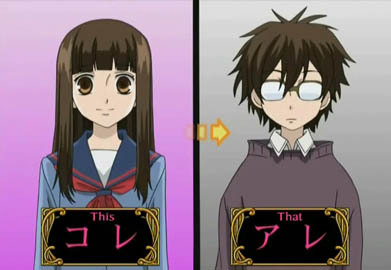
Don't fucking look at me like that. I watched Ouran at an impressionable age and now I'm bigender. It has a place in my bunny heart. It is foundational to the person I grew up to become.
Cardcaptor Sakura

I watched this dubbed into Spanish back when I was young, and admittedly I don't remember 60% of it, but that doesn't mean I don't think fondly back on it moreso than any other show I ever saw back when I was a child, and one that I've had a lot of joy in going back to it as I've grown older.
I don't have as much to say about it as I do some other shows, and like with Soul Eater, it feels like everything there is to be said about it has already been said elsewhere and better; it is one of the foundational texts for the modern magical girl genre, it is one of the most beautifully animated and designed shows I've ever seen, and the best at keeping the distinct house styles CLAMP is recognizeable for intact in animation as far as I'm concerned. It's my personal choice for what other people would call a "comfort" show; but I do not wish to diminish the story or reduce it to an aesthetic the way a lot of people do for shows like this, considering just how strong the character dynamics and their progression throughout the story are, and the wealth of emotional depth that can be found in just about everyone's arcs.
While the overarching plot and the world of the story aren't as interesting as some other shows of its type, its strengths lies in how it uses that as a solid foundation through which to explore a distinct aspect of the human condition through each of its characters - love, grief, loneliness, devotion to another and many others.
Kekkai Sensen (2015)

This is one of those cases where I feel like I'm going to repeat myself. Take everything I said about Soul Eater, put it here. It is stylish, it's got a strong central cast of characters that are all equally fun and contribute the same amount to the narrative. It's got some of the most intense, lovingly rendered large-scale action scenes I've seen, along with some of my favorite small, touching narratives; thanks to one of the best urban fantasy settings ever put together.
The first season's storyline is a blend of manga chapters with an anime-original plot, while the second season mostly adapts the manga much more closely so it doesn't come together as tightly as the first does, but it is more of the best show of its type of the past decade as far as I'm concerned; and nothing takes away just how incredibly tight that first season feels, even if the final episode was months late and had to go double length while the animation melted a little. And yet, it all comes together beautifully in the end.
Angel Beats

What a surprise this show was. I'll always feel a little bittersweet about it, due to the circumstances that led me to see it, but I'm forever grateful I did. Angel Beats' greatest strength is the way that it disarms the viewer by presenting a fun, albeit somewhat dark supernatural comedy about kids in the afterlife, letting one get comfortable with the silliness of the world before really taking the "children in the afterlife" premise to its logical conclusion: This is a story about death, trauma, tragedy, and moving on- Quite literally, in this case- from the things that weigh us down.
I make no hyperbole when I say that this show has the single strongest emotional climax I've ever experienced, and every time I watch it again I am moved to tears, sometimes more than last. I can't say much, since a lot of what makes this show fun is experiencing it, and realizing the depth of the world along with our point of view character; but the biggest endorsement of it I can give is how gracefully and tactfully it deals with complicated subjects such as abuse, disability and addiction in stories where you know how they all end, and yet give you a satisfying emotional conclusion while also keeping the mood balanced between cheerful when it has to be and heartbreaking, with the latter becoming more and more common by the end of the story.
It's a story about growing up, as much as it is a story about dying. It knows the tragedy of its premise and it chooses to ask the viewer to find joy in the time they have with its cast - a beautiful metaphor for life itself woven deeply into the narrative and never once stated out loud. We know where this story is going, but we're here now, so we might as well have a little fun along the way. That is ultimately what youth is about.
22 notes
·
View notes
Note
can i read your thesis pleaaaaaseeeeeeee?
owww i'm sorry but i don't feel comfortable sharing it online mainly because of privacy / professional issues :( however if you're into abjection, feminist and queer readings of the body, horror/monster theory i'm happy to recomend some amazing works (much better than mine!)
- Clover, C. (1992) Men, Women, and Chain Saws: Gender in the Modern Horror Film. Princeton: Princeton University Press.
- Mittman S., Hensel, M. (ed.) (2018) Classic Readings on Monster Theory. Leeds : Arc Humanities Press. pp. 43-54.
- Creed, B (1993) The Monstruous Feminine. Film, Feminism, Psychoanalisis. New York: Routledge
- Halberstram, J (1995) Skin Shows. Gothic horror and the technology of monsters. Durham: Duke University Press.
- Haraway, D. (1991) Simians, Cyborgs and Women: The Reinvention of Nature. New York: Routledge.
- Kristeva, J (2016) Pouvoirs de l’horreur. Un essai sur l’abjection. Paris: Éditions du Seuil.
- Gelder, K. (2000) The Horror Reader. London: Routledge.
- Grosz, E. (1990) Jacques Lacan. A feminist introduction. London: Routledge.
- Grosz, E. (1990) The body of signification. In: Abjection, Melancholia and Love (ed. Benjamin, A., Fletcher, J.) London: Routledge.
- Grosz, E. (1994) Volatile bodies. Toward a Corporeal Feminism. Indianapolis: Indiana University Press.
- And of course... Bodies That Matter by Judith Butler!
32 notes
·
View notes
Text

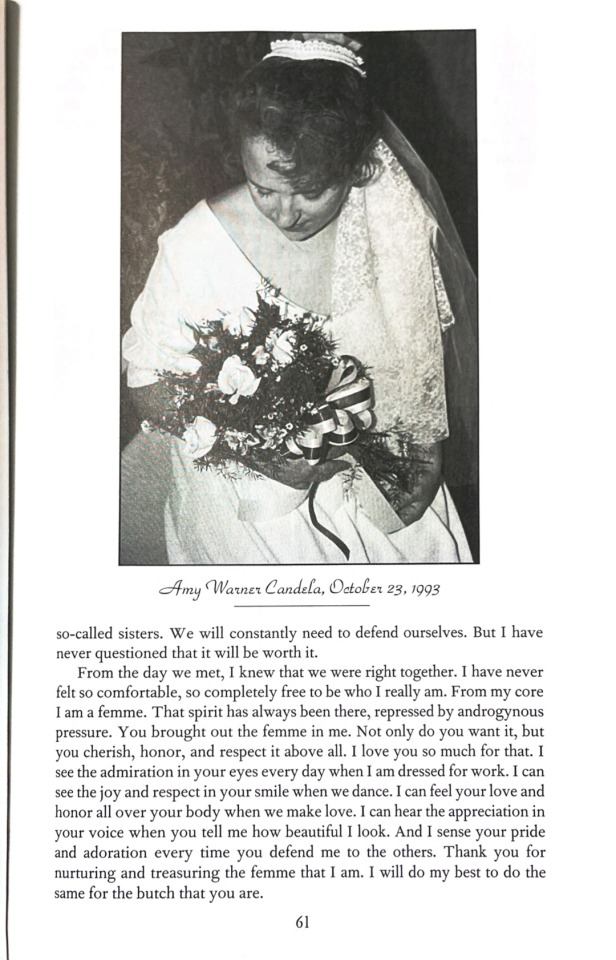

Amy Warner Candela - For Charlie on the Eve of Our Wedding in The Femme Mystique edited by Leslea Newman
In honour of valentine's day this past week 💌
ID under read more
ID: Three parts of an essay from Amy Warner Candela - For Charlie on the Eve of Our Wedding in The Femme Mystique edited by Leslea Newman
The first part presents text.
The author is Amy Warner Candela.
The title is For Charlie on the Eve of Our Wedding.
The text continues and it reads:
October 22, 1993
"Tomorrow we are to be married, and I am confident that it will be the wedding I have always wanted.
Every detail of what will become the wedding is precisely what we want; nothing is out of place. I will be wearing the most beautiful dress and the most beautiful veil I have ever seen. You will look gorgeous in your tuxedo. The flowers are exactly right. The ceremony will be perfect, because we created it together. Our closest friends and most of our families will be with us, just as we have always wished. The music is what I picked out as a little girl. We have planned and prayed and organized and practiced and crossed our fingers for months now, and I know it will all be worth it.
What is the reason that this is everything that I have wanted? You. You are all that I want in a woman. In my mind's eye, the wife I pictured never had a face. Then you came along, and the blank was filled. That butch dyke is you!
You already know why I am marrying you: I want to spend the rest of my life with you. I want to sleep with you every night and make your breakfast every morning. I love knowing that you'll be at home waiting for me after another very long day. I love knowing that every time I feel pleasure, it will be from your touch, your words, your heart. I love knowing that you always make me feel safe, you constantly protect me. I love know- ing that no matter how hard it gets for us, you and I will never abandon our commitment. I will love being your femme wife.
I have always known these things, even before you proposed and put that diamond on my finger. But I want our commitment to be blessed. I want to share our marriage with the people we love, and I want to show the world that I am proud to take your hand. This is why I want to share a last name with you.
Amidst all of the chaos of the last few days, I found time to think about what it will mean to be your wife. It is going to take a lot of patience, thought, and strength. I'm afraid we will always have to face troubles from our own community. We will always have to turn away from the stares of our"
The first part is on page 60 of the book.
Second part shows a picture of a woman in a wedding dress, veil and holding a bouquet of flowers. Text directly underneath the image reads: Amy Warner Candela - October 23, 1993.
(text continues from the other page) "so-called sisters. We will constantly need to defend ourselves. But I have never questioned that it will be worth it.
From the day we met, I knew that we were right together. I have never felt so comfortable, so completely free to be who I really am. From my core I am a femme. That spirit has always been there, repressed by androgynous pressure. You brought out the femme in me. Not only do you want it, but you cherish, honor, and respect it above all. I love you so much for that. I see the admiration in your eyes every day when I am dressed for work. I can see the joy and respect in your smile when we dance. I can feel your love and honor all over your body when we make love. I can hear the appreciation in your voice when you tell me how beautiful I look. And I sense your pride and adoration every time you defend me to the others. Thank you for nurturing and treasuring the femme that I am. I will do my best to do the same for the butch that you are."
The second part is on page 61 of the book.
Third part has text that reads:
"I know the anguish that you have experienced as a butch. I cry for the pain that people have inflicted upon you. I try to dispel your fears of the simplest things: a certain touch, a trip to the ladies' room, a doctor's office visit. I wish I could erase the malevolence for you, just as you constantly comfort me. My sorrows have been different yet the same. I never fit in with the crowd. Assumptions are made about me every day, and expectations of me are great. I must sustain my inner strength; not just as a lesbian, but as a femme. I never knew that being a femme would be so much harder than being queer. We are both gender-benders: you challenge the straight community while I challenge the lesbians. We are both cross-dressers: you wear men's clothing, I refuse to even attempt the lesbian androgynous status quo. I am convinced this is why we are so perfect together: we comfort, and complement, and contrast all at the same time.
We must continue to defy the expectations of us. We can draw upon each other when we need to stand tall against pressure from the community in which we first found our strength and reassurance. Our wedding is a challenge to that community. How many times have we heard, "Are you both wearing dresses or tuxedos?" It's ironic that lesbians asked this question most often, and that we must explain and defend our freedom to the people who claim to fight for it.
Despite the obstacles, I come to you with love, with faith, and with the promise to give you all that is me.
(signed) Amy Warner Candela"
Third part is on page 62 of the book.
End ID
26 notes
·
View notes
Text
Beauty and the Borg – A B7 Shipper’s Manifesto
So. We’ve come here in my life where I just need to talk about ships I love and everyone has to see this. Only not but whatever. I’m gonna try to break this down old school in how I remember shippers manifestos in livejournal days, complete with images. And thus to begin:
What is Star Trek: Voyager?
Unless you live under a rock you’ve probably just heard of Star Trek, maybe not watched it but heard of it. Starting in 1966 the Original Series was released, ran for three years, was canceled due to an infamous error in Neilson ratings and established the franchise. There was an animated series people often forget about, six movies for the Original series, and then in 1987 they brought it back as a live action show called Star Trek: The Next Generation. It did so well and engrained itself in the conscious of many people that they often refer to it as the best Trek but believe me that’s a debate on it’s own. And thus had it’s own spin off, Deep Space Nine in 1993. While not as popular as TNG it’s grouped into what people call the 90s Trek. With the last one being the last spin off in 1995: Star Trek: Voyager.
Where DS9 introduced the first black captain (though it took three years for him to get that promotion, boo), VOY introduced the first female captain lead of a Star Trek series. The premise of the show was that on a hunt for some resistance fighters both ships are pulled through the Alpha Quadrant to the Delta Quadrant. Approximately seventy-thousand light years from home. Due to the choice made by the captain, Kathryn Janeway, they are then stranded there and the crews of the ships band together on Voyager to make their way back to the Alpha Quadrant and get home.
That’s an extreme simplification but basically Lost in Space for Star Trek.
And that leads us to the characters of this essay:
B’Elanna Torres - The Engineer Who Built This Society


A half-human, half-klingon Maquis born to John Torres (human) and Miral (Klingon). She and her mother were the only Klingons on the colony where they lived and as such B’Elanna was teased and made fun of at school. Her father eventually couldn’t take being married to a Klingon and left her and her mother, an incident which left B’Elanna worrying was her fault being half Klingon.. She was then raised on the Klingon homeworld until she left to join Starfleet Academy…
And quit it.
Basically she couldn’t find herself fitting in yet again and left to once again find her place which brought her to the Maquis.
The Maquis were a group of resistance fighters, depending who you ask of course, that fought for the freedom of species, mostly Bajor, from Cardassian rule. They were considered to be a threat by the Federation and hunted down by both Cardassians and the Federation. B’Elanna was only in the group roughly for a year before the incident that stranded them in the Delta Quadrant occurred. She did think of that group as her family though and felt both indebted to them and loved them.
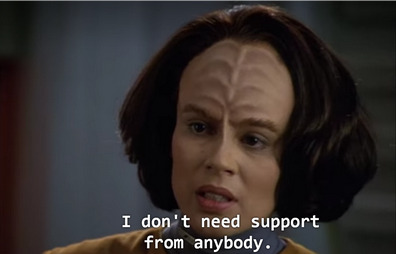
While on Voyager she became Chief Engineer and was damn fucking good at it but let’s get into the heart of her character here. B’Elanna suffers from depression over the course of the series and self doubt when it comes to herself while not at the job. She pushes people away while simultaneously hoping they’ll stay anyway.


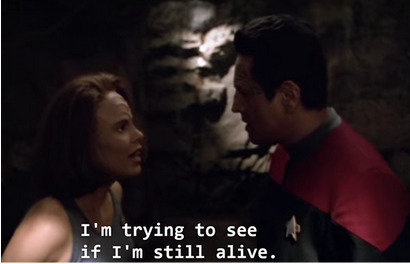
She pushes herself to her limits, trying to see if she’s enough and never really finding that answer. She also struggles with a connection to both her parents and her cultures; coming more to terms with the Klingon culture as time goes on and also striking up conversation with her father again. She’s also a big romantic who reads romance novels.
Tragically that kicks off her romance with Tom Paris and they eventually get married and have a kid together and even then B’Elanna worries for her child who will still look Klingon. She doesn’t want her kid to have to go through what she did and suffer for it. In the end she chooses to accept her child will look like her as a Klingon but it’s clear the thought will linger on for her regardless.
She’s blunt and sarcastic and brash, takes no shit, and loves her friends very very deeply.
Seven of Nine - What I Want is to be Useful

Seven of Nine didn’t come in until season 4 of Voyager. Basically here because of sexism and the writers wanting that sweet sweet sex appeal. She was a human, once called Annika Hansen born to Magnus and Erin Hansen. Her parents were scientists who were studying the Borg and took their daughter along with them for…reasons. Look it wasn’t very smart.
Lo and behold the Borg caught on to the fact they were being watched and assimilated Seven and her family. At the time she was only six and thus spent most of her life in a borg cube, as such she has a…unique take on cultures.
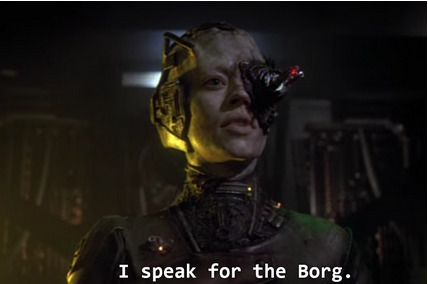
She ended up on Voyager because Voyager made a deal with the Borg to get through their area of space. Then Janeway cut her connection to the Borg and Seven was left floundering and suddenly alone. The Borg are a hive mind type species and she’d had that for over twenty years of her life. The shock left her reeling though she’d hardly admit it.
Seven is a complicated character in a lot of aspects, the series generally tries to explore her gaining her independence and learning about herself and where she fits in. It’s not perfect and often clumsily written, especially when it comes to the Doctor teaching her. They do push a lot of gender ideas as well which haven’t aged well. And leave her in those terrible catsuits. She also, due to her stubbornness, butts heads with a lot of the characters as she’s trying to figure this out.

(Seven also shows up later in the Picard series but I am only talking about her as she pertains to Voyager in this essay.)
Unlike B’Elanna she’s not really a romantic though the show does give her romance options including setting her up with Chakotay right at the end for…also reasons. And where B’Elanna only takes the mother position towards the end of the show Seven actually has a character who is like her son, another ex-Borg named Icheb introduced in season 6. As well as looking after Naomi Wildman (first baby on Voyager, we all love her) who she admits is family.
For all the imperfect writing they have about her I’ll give them that.
Seven is logical and cold, sure in her abilities and has a drive for perfection.
A Collective of Two - B7

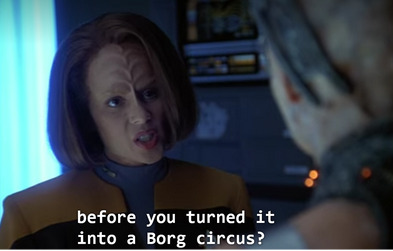

To say these two don’t get along at first is an understatement. B’Elanna is mistrusting of Seven and Seven looks down on B’Elanna. They both see each other as stubborn and rude and want the other out of the way while they work (See Scientific Measure in which they argue in a Jefferies Tube and Message in a Bottle where B’Elanna does a full call out on Seven). At one point (Day of Honor) B’Elanna even asks Seven if she regrets everything she did as Borg, assimilating other cultures, and Seven says no. Granted if she asked that again to season seven Seven (har har) the answer would be far more complicated.
Seven comes to value her independence and individuality across the series. She comes to see the Voyager crew as her collective. In one episode (called One, I’m on a roll here, let me have this.) Seven is left alone while the rest of the crew is in stasis. The EMH is around but even he gets disrupted and Seven is by herself on the ship with only her hallucinations and herself to talk to. It’s the end of the episode that stands out here.

In the beginning of the episode she approaches B’Elanna and Harry and well, annoys them. She doesn’t see an issue with this and is not here for friendship. The end of the episode she approaches them again, and I guess Tom is there too, whatever, and asks to sit with them. When they say yes she sits down next to B’Elanna and admits she felt the need for companionship. It’s a huge step with Seven seeking others out.
On the other side is B’Elanna the episode right before that, Demon. She isn’t allowed to go down to a planet to look for her friends because Chakotay is worried she isn’t a ‘cool head’ that’s needed for this assignment. After a bit of a fight it’s then that B’Elanna requests Seven go then in her place, after all “Nobody’s head is cooler than hers”. An insult and a compliment in one, B’Elanna and Seven’s relationship in a nutshell. But the point here is that B’Elanna has come to trust Seven. Towards the end of season four there’s a measure of respect between them and acknowledgement of each other’s skills.
(Also see Message in a Bottle, when B’Elanna first approves of a plan Seven sets forth. And waits till no one is in the room to see her do it.)
Which brings us to the end of season four. Voyager has potentially found a way home (spoiler alert: there’s three more seasons. They have not.) and at one point B’Elanna and Seven are working together on the other ship which prompts a conversation about Earth. Seven during the conversation points out that B’Elanna seems eager to return, which B’Elanna denies. Then as Seven says it “You were a member of the Maquis. Starfleet Command will no doubt hold you responsible for a multitude of crimes. You will find nothing on Earth but adversity.” And we get the following scene:


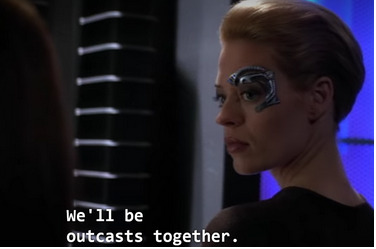
Of course then B’Elanna plays it off as a joke later but the line still stands out to me. It truly does show how the two of them view themselves. B’Elanna isn’t accepted because she’s half-Klingon or because she’s a Maquis. Seven isn’t accepted because she’s ex-Borg or, in the words of B’Elanna, she’s rude. While they’ve carved out an area of acceptance on Voyager that doesn’t mean it extends beyond that.
Earth is an unknown for the both of them at this time. They’re more alike and are starting to see that even if they won’t admit it. Yet.
Of course, they’re also still not about to admit it in season five.
Season five has a…bad episode in it called Infinite Regress that regrettably I have to talk about. In it Seven is taking on other personalities from people who she assimilated over the years. At one point she takes on a male Klingon and, well. Tries to mate with B’Elanna which includes biting her on her cheek. The only saving factor of that episode is that it starts the Seven and Naomi friendship and also this line:

That’s it.
Honestly season five isn’t the best for B7 stuff, there’s a few scenes like in Extreme Risk when B’Elanna is going through some major depression and Seven comes to her to discuss a project or even in the Course: Oblivion episode though sadly that’s not actually them but clone selves. And I say that with an absolute straight face even as a snicker about it. Turns out you can forget you’re a clone but can’t forget you’ve got chemistry with each other.
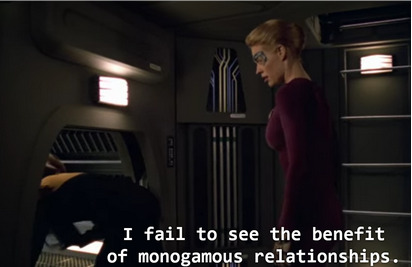
Sure girl. Tell her that after she just got married, just say you wanna open her relationship to include you already.
There is however one fun and stand out scene towards the end of season five, see it turns out Seven has been stalking B’Elanna (and Tom) to study mating rituals. Honestly, worst choice there, Seven. Needless to say, B’Elanna notices and doesn’t take this “study” well.



It’s nice to see not all the antagonism is gone. But they still have time to reach an understanding! Sorta. Also that episode is Someone to Watch Over Me. Don’t watch it, that’s the only good scene.
I gotta add one scene however from Relativity even if B’Elanna isn’t in the scene herself. Tom approaches Seven to team up for a ping pong match and of course Seven isn’t interested. Until B’Elanna is brought up.
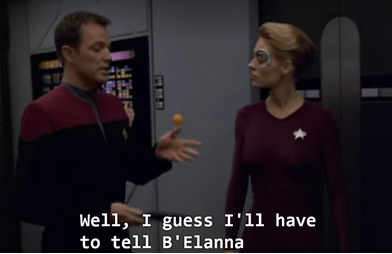

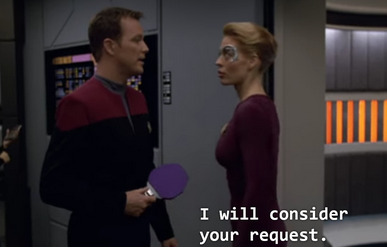
Like Seven. Babe just say you wanna impress B’Elanna.
And thus we go to season six.
Okay I’ll be honest, this season doesn’t have a lot for them either. Season four and seven are standouts in their interactions imo. And since this is my essay it’s all my opinion. I blame the het ships they were both forced in.
But in Survival Instinct they do get a nice scene together. In the episode Seven is suffering having come into contact with her old unimatrix and remembering something she did. She can’t fully piece it all together and it’s shaken her up. At one point B’Elanna tries to comfort her while they’re going over data and Seven snaps back that she has no feelings about the past. And then clearly regrets it, something season four Seven absolutely wouldn’t care about.


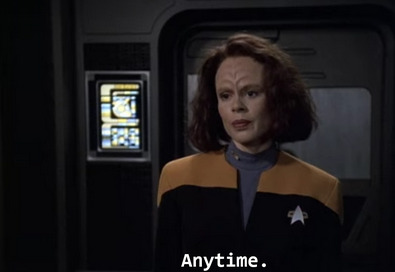
It’s a show of how far they’ve both come. B’Elanna offering comfort to Seven and Seven acknowledging that her words hurt B’Elanna. It’s a small subtle scene that makes me really happy.
There’s a few other scenes here and there too, in The Voyager Conspiracy Seven once comms B’Elanna right as she wakes up and I just find that funny. Like sure, don’t wait till you’re on shift. A moment in Tsunkatse where B’Elanna jokes about Borgs and fun to Seven. And then in Fury when Kes gets to engineering there’s a blink and you’ll miss it scene where B’Elanna reaches back to pass Seven a phaser and they’re both just very in sync in the scene. And then B’Elanna dies and Seven sees it :( at least it’s all undone in the end. She’s fine. Death in Star Trek: Voyager is a punch card honestly; punch it ten times and get a free replacement from another reality. (Sorry Harry)
That ties up that season in a tragically low point for them but that’s okay because it’s season seven.
Season seven was the last one Voyager had. B’Elanna marries Tom and gets pregnant, Seven gets into a bit of a rushed relationship with Chakotay right at the end. Voyager finally gets home but these two are gay between them and the joke’s on the Voyager writers. Unlike them I can pretend Tom/B’Elanna never happened at all.
Right at the start is the episode Imperfection where a Borg implant Seven has is failing and she must face the fact she might die. In response she chooses to work, as she says “What I want is to be useful.” And for that she chooses not to go to her usual post in Astrometrics but to hide out in Engineering. So I could infer that Engineering, and thus B’Elanna who is in charge of it, is a safe space for her. That’s made even more clear when B’Elanna finds her and they have a talk about life and legacy.



It’s an incredibly soft and meaningful scene, where B’Elanna expresses that Seven has made an impact on everyone (herself quietly included). It’s interrupted by the Doctor finding them but that leads to B’Elanna coming to Seven’s defense and saying she can stay in Engineering. B’Elanna will keep an eye on her.

Unlike at the end of season four where B’Elanna lumps them together as outcasts and then jokes about it, this time she is completely serious. She has Seven’s back, they are “[the] difficult patients” who are in this together after all. Sadly that’s the last they interact this episode however brief it was it really goes to show how they’ve come together as a unit and a friendship.
There’s a few more scattered moments in season seven episodes, in Drive Seven is the one who convinces B’Elanna to accept Tom’s hobbies. Like she needs to. Look I’m not bitter (lies). In Lineage when B’Elanna finds out she’s pregnant and stumbles Seven is the one to reach out to steady her and deliver that news to her. It’s almost funny that Icheb is also there and once had a crush on B’Elanna, like wrong ex-Borg Voyager writers.
This does lead us to Human Error though, which has quite a few more moments with them but also sadly the last time they really interact.
In the episode Seven has been taking advantage of the holodeck to imagine different moments, including herself without Borg implants. One of the moments is B’Elanna’s baby shower though they don’t interact there. Instead Seven misses the real baby shower and awkwardly arrives at engineering with a belated gift for B’Elanna.

It’s cute, Seven’s really trying to connect here. And then keeps trying to connect.

Girl…I don’t have time (okay I do) to explain how gay this is. Seven could have chosen anyone on the ship and choses to try to connect with B’Elanna here. Including noting her appearance and asking about it. Of course the funniest thing is B’Elanna’s side eye after the fact.
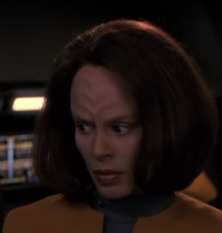
Of course the scene is meant to be humorous, look how Seven once again struggles to connect to people but I chose to take it at face value here. Every other time it’s been B’Elanna reaching out to connect with Seven and this time it’s Seven reaching out to connect with her. They’re both trying in their own weird way.
The episode ends without further interaction but there is one moment at the end:

Like the Tom moment above I just think it’s funny that people are out here like ‘no Seven you should come. B’Elanna is there :)’
And that’s it. That’s the B7 in canon moments broken down. So let’s talk more about them because I can’t shut up.
Okay so like…why?
For the past oh…seven years I’ve been talking about B7 on my blog probably too much. I just think they’re neat! But now comes the time to explain that and I’m not the best at words but I’ll try.
For me it’s about the mirror they are to each other. Both are characters struggling with identity and where they fit in in a world that doesn’t want to fit them in. They’re extremely capable and smart but flawed. Whether the show writers realized it or not they made these two characters so similar and set up exploration of that and then just…never delivered.
I want the exploration there, I want to dive into what it means to see someone as a reflection of yourself but then acknowledge the good parts they have like when B’Elanna encourages Seven about her legacy and what an impact she has. Does she know that she has that same legacy? Does she even know she has those same doubts?
For two characters who are vastly different in personality there’s just so much they share and can share. They’re both disillusioned with Starfleet and people and yet trying. They’re put into boxes by society and just can’t fit. They’re done bad by the writers in pretty fucking horrible effect.
There’s a trilogy of books called Voyager String Theory, really only the first two are important in the context of B7 though. In the first book they crash land on a planet and at one point Seven has to give B’Elanna some borg nanoprobes to help her heal.

“We would be the collective- a collective of two.” Seven tells her. That alone struck me as how the two of them could be. Outcasts together. Difficult Patients. A Collective of Two.
(Also that book has a lot more gay points in it, please read it:

Like, c’mon.)
It shows the potential of them and while Picard really killed, hm, a lot of things, I always wanted to imagine a future where they got back to Earth and were that Collective. Dealing with this new area together. Oh sure they’d get on each other’s nerves, part of the fun for me is that I don’t think they’d ever really lose that antagonism, but after everything they’ve been through you can see how they’ve come to respect and count on each other.
TL;DR…90s trek writers accidentally made it gay again.
Supplemental
I’ll be honest, I have a tendency not to read fics of pairing I myself write because I’m terrified I might subconsciously take something from another writer without even realizing it in that same area of fanfic. So instead I’ll rely on two others fic rec lists:
https://trillscienceofficer.tumblr.com/post/706359122066636800/trillscienceofficers-belannaseven-fic-rec-list
https://punkbxt.tumblr.com/post/622585834575626240/b7-fics-that-i-read-over-and-over-again-without
I am in fact on there twice (favourites and you’ve got my number are mine) sooo feel free to ignore those if you’ve had enough of my writing at this point.
For other things I’d suggest punkbxt on tumblr for their amazing b7 art and comics. Again please read Voyager: String Theory at least the first book. It is gay.
There are also far far better people at putting things into words then me on good old hellsite dot com so honestly just go through the b7 tag. I wouldn’t recommend the character tags themselves though. Trust me.
If you made it this far then thank you for reading and I hope I could nudge you a little bit in the B7 direction (and thanks to @trillscienceofficer for all the help on this). Live fast and prosper~
#b'elanna torres#seven of nine#b7#beej talks star trek#like a whole fucking lot#trek femslash#I'm not even joking I stayed up till 2am working on this
73 notes
·
View notes
Text
@umlexis sorry for writing a whole essay about stex pfjslk i love trains <3
so the basic plot is engines from all the world are coming together to compete to see who will be the new champion and rusty the underdog steamer wants to enter to prove that steam is still relevant and also impress his crush. things go off the rails (pun intended). the main antagonists are elvis, a nonbinary bisexual drag queen in a polycule, and a trucker-slash-clown-slash-conman. train god is there. a brick gets thrown into the audience.
stex originated in london and ran there from 1984-2001, but there's a revival happening next summer! it's also been running in germany since 1988 in a special custom-built theater (i got to see it there last spring it was so so cool<3), so there were 2 separate versions of the show happening at the same time for a while. it's also been through MULTIPLE rewrites, the most recent was in 2018. there's supposed to be a new cast recording for the update coming out soon and i'm just. staring impatiently.
a lot of videos/recordings got scrubbed recently which is honestly such a bummer, pour one out for the 1988 bochum concept album </3
ENGLISH RECORDINGS:
the 1984 original london cast recording is a good place to start imo! it's not a full recording so there are some bits of the story missing, but the actors are all fantastic
the 1987 music & selections album is actually not a cast recording, it's just contemporary artists singing (modified) songs from the show, but i still enjoy it a lot
the 1993 new starlight london cast recording is for the 'new starlight' show rewrite in 1990. also not a complete recording but it has some of my favorite versions of the songs! the stretch from freight to crazy is just chef's kiss
GERMAN RECORDINGS:
the 1989 bochum cast recording is a complete recording, a lot of the songs on the internet archive are out of order/mislabeled tho :(
the 1991 bochum cast recording is also not a complete recording, has some versions of songs that aren't on any other recordings
the 2013 bochum cast recording is a full recording of the show! it's in german and just fantastic all around. it got scrubbed from youtube a few years ago sadly but the internet archive still has it
SPANISH RECORDINGS:
the 1997 mexico city cast recording isn't a full recording and the quality isn't a bit crunchy, but it's still good! there was supposed to be a professionally released album but it never happened :(
the 2000 amateur spanish cast recording is also not a full recording but tbh it slaps and the quality is great
-
this channel on youtube has clips from various versions of the show that's a good place to start watching! i also have a pretty big boot collection so you're free to shoot me a message if you want any :)
posting some misc vids i like a lot too!
youtube
youtube
youtube
youtube
#this is so long i was possessed by the spirit of the starlight express itself#hope this is helpful!!#stex#david.txt
17 notes
·
View notes
Text
THIS DAY IN GAY HISTORY
based on: The White Crane Institute's 'Gay Wisdom', Gay Birthdays, Gay For Today, Famous GLBT, glbt-Gay Encylopedia, Today in Gay History, Wikipedia, and more … February 2



1711 – The great Austrian statesman Prince Wenzel Anton von Kaunitz (d.1794) was born in Vienna. He was an Austrian-Czech diplomat and statesman in the Habsburg Monarchy.
A proponent of enlightened absolutism, he held the office of State Chancellor for four decades and was responsible for the foreign policies during the reigns of Maria Theresa, Joseph II, and Leopold II. In 1764, he was elevated to the noble rank of a Prince of the Holy Roman Empire. Single-handedly he engineered an alliance between traditional enemies France and England.
Eccentric, arrogant, conceited and always happy to hear the sound of his own voice, he is said to have had a virtual harem of young men.

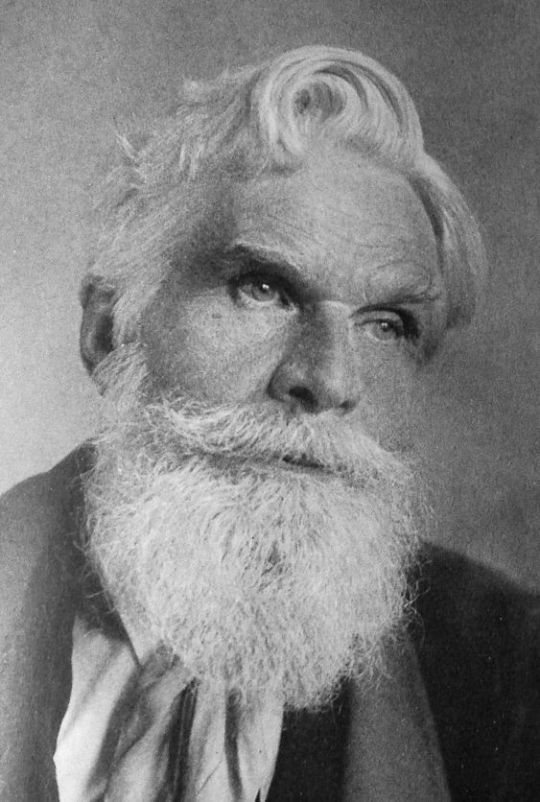
1859 – Havelock Ellis, British psychologist and sexologist, born (d.1939); Ellis's monumental seven-volume Studies in the Psychology of Sex (1897-1928) was not only of the greatest importance in changing Western attitude toward sex, but has influenced almost all writers ever since. Given the nature of his major interest, he was more than entitled to a full-fledged fetish all his own.
From the beginning, his marriage was unconventional (Edith Ellis was openly lesbian), and at the end of the honeymoon, Ellis went back to his bachelor rooms in Paddington, while she lived at Fellowship House. Their "open marriage" was the central subject in Ellis's autobiography, My Life. According to Ellis in My Life, his friends were much amused at his being considered an expert on sex considering the fact that he suffered from impotence until the age of 60, when he discovered that he was able to become aroused by the sight of a woman urinating. Ellis named the interest in urination "Undinism" but it is now more commonly called Urolagnia.
Ellis's Sexual Inversion, the first English medical text book on homosexuality, co-authored with John Addington Symonds, described the sexual relations of homosexual men and boys, something that Ellis did not consider to be a disease, immoral, or a crime. The work assumes that same-sex love transcends age as well as gender taboos, as seven of the twenty one examples are of intergenerational relationships. A bookseller was prosecuted in 1897 for stocking it. Although the term 'homosexual' is attributed to Ellis, he writes in 1897, "`Homosexual' is a barbarously hybrid word, and I claim no responsibility for it." Other psychologically important concepts developed by Ellis include autoeroticism and narcissism, both of which were later taken on by Sigmund Freud


1916 – Xuân Diệu (d.1985), was a prominent Vietnamese poet. A colossal figure in modern Vietnamese literature, he wrote about 450 poems (largely in posthumous manuscripts) especially love poems, several short stories, and many notes, essays, and literary criticisms.
In 1943, he joined the Viet Minh and became one of the leading poets writing to promote resistance against the French.
Although well known for his love poems, he was married for only six months without consummating the marriage before divorcing from his wife and died a bachelor.
Many people believe that he was homosexual along with his lifelong friend the famous poet Huy Cận, as shown through his many poems about love dedicated to (and apparently addressed to) various men. These poems include "Tình trai" ("Man's Love", about the love affair between the French poets Arthur Rimbaud and Paul Verlaine) and "Em đi" ("You leave", a heartfelt poem dedicated to a younger man with whom the poet shared a house for several years). In his memoirs published in 1993, the writer Tô Hoài confirmed that Xuân Diệu was reprimanded while in the Viet Minh for molesting other men in bed.


1946 - J. E. Freeman was an American actor (d.2014), often cast in tough guy roles.
His first movie appearance was in the early 1980s actioner An Eye for an Eye in which he played a tow truck driver who minces words with Chuck Norris.
Freeman was especially known for his menacing characters roles: the evil gangster Marcello Santos in David Lynch's Wild at Heart, the terrifying Eddie Dane, ferocious gay hitman from Miller's Crossing, and the infamous scientist Wren in Alien Resurrection. Other notable apparitions in : Ruthless People, Patriot Games, Copycat and Go.
Freeman was openly gay. At age 22, he admitted his sexuality to the United States Marine Corps to avoid being drafted to the Vietnam War, leading to his discharge. He was HIV-positive from circa 1984. In 2009, he published a letter to the editor on sfgate.com, detailing his reminiscences of the 1969 Stonewall riots. He wrote poetry and had a tumblr blog (Freedapoet) dedicated to his poetry.
Freeman retired from acting in 2004. He died in the evening of August 9, 2014. He was 68.


1970 – Casey Spooner is an American artist and musician. He was born in Athens, Georgia and resides in Williamsburg, Brooklyn. Spooner is openly gay. While attending the Art Institute of Chicago he met Warren Fischer. The two went on to cofound Fischerspooner in New York in 1998.
Spooner has submitted works for Deitch Projects and an album by R.E.M. A promotion for Fischerspooner's second album included an art Salon/Art Exhibition of all the images used in making of the album, this has since been linked to Warhol.
Casey joined experimental New York performance ensemble The Wooster Group in 2007, taking on the role of Ophelia's brother Laertes in their production of Hamlet (which featured two Fischerspooner songs that were composed for the show). During this time, he also began work on a third Fischerspooner album (with Warren Fischer). Entertainment was released in North America via the band's own label FS Studios on May 4, 2009, produced by Jeff Saltzman (The Killers, The Black Keys, The Sounds). An American and European Tour, known as Between Worlds, continued all through 2009. Like in other Fischerspooner's performances, Spooner was the main figure of the show.
In January 2010, Spooner distributed online his first solo work, the song Faye Dunaway, as a preview of a 2010 solo album entitled Adult Contemporary. He served as the opening act for Scissor Sisters on their North American tour. This was possible thanks to the funding provided by his fans through Kickstarter, the crowdfunding online platform. Currently, he is at home in NY after releasing his solo album, Adult Contemporary.


1979 – David Paisley is a Scottish actor, his best-known for roles are midwife Ben Saunders in Holby City and Ryan Taylor in Tinsel Town. Openly gay himself, both his characters were controversial due to their sexual orientation - a lingering kiss with his on-screen boyfriend in Holby City led to 400 complaints to the BBC.
Paisley grew up in Glen Village near Falkirk. At 15 he went to a gay youth group where he eventually met his first boyfriend. At 17, he went to Glasgow University to study physics, during which time he appeared in a community workshop and then later he went to Caledonian University to study Optometry. At 18, Paisley finally came out to his family who were supportive and helped in his efforts campaigning against the Keep the Clause campaign, a British anti-homosexual movement.
He had a long-term relationship with Alex Mercer, (with whom he shared Britain's first on-screen gay threesome scene in Tinsel Town). David also had a part in the film adaptation of David Leavitt's While England Sleeps.
He has been voted 'Britain's sexiest man' by readers of Gay Times magazine.
He appeared in the BBC Scotland soap opera River City as Rory Murdoch until December 2008, a part to which he may return.
David recently starred as Gary in the play The Back Room by Adrian Pagan at the Cock Tavern Theatre in Kilburn, London. David also starred in the successful stage production of Mumah in early 2009. October 2009 has seen him take to the stage again in the UK Tour of Over The Rainbow - The Eva Cassidy story, in which he plays the part of 'Danny Cassidy'.
In 2010 David made his directorial debut with the play The Lasses, O at the Edinburgh Festival.


2005 – Austria: Transgender Europe (TGEU) is founded in Vienna during the first European Transgender Council. This NGO works "to support or work for the rights of transgender/transsexual/gender variant people." It also runs the Trans Murder Monitoring project, which records and reports the many people who are killed each year as a result of transphobia.

2009 – The Justice Department undid a small part of the damage that top officials caused in a scandal of politicized hiring and firing during the Bush administration. The department rehired an attorney who was improperly removed from her job because she was rumored to be a Lesbian.
NPR first broke the story of Leslie Hagen's dismissal in the previous April, and the Justice Department's inspector general later corroborated the report. Now, Hagen has returned to her post at the department's Executive Office for U.S. Attorneys.
In 2006, Hagen was the liaison between the main Justice Department and the U.S. Attorneys' committee on Native American affairs. The chairman of that committee, Tom Heffelfinger, described Hagen to NPR last year as "the best qualified person in the nation to fill that job." Hagen's performance evaluations had the highest possible ratings—"outstanding" in each of five categories. The job came up for renewal every year. After the first year, Hagen was surprised to hear that she would have to move on.
NPR's Ari Shapiro notes that "it is not a perfectly happy ending for Hagen" because "nobody official from the department ever apologized to her for what happened" and she still owes thousands of dollars in attorney fees that the Bush Justice Department refused to pay.


11 notes
·
View notes
Photo

✨best books i read in 2022 in no particular order✨
Beautiful Country by Qian Julie Wang (2021)
This "memoir of an undocumented childhood" is a beautiful story of a family who cared for and looked after one another and of a child who had a lot of fears but was at the same time wonderfully brave and curious and determined.
My Brilliant Friend by Elena Ferrante (2011)
This is the story of Elena and Lila, two childhood friends living in a rough neighborhood on the outskirts of Napoli. We follow their story, narrated by Elena, until they become teenagers, when their paths diverge and their friendship is transformed forever.
Persuasion by Jane Austen (1817)
Persuasion tells the story of a second chance, the reawakening of love between Anne Elliot and Captain Frederick Wentworth, whom eight years earlier she had been persuaded not to marry.
Giovanni's Room by James Baldwin (1956)
This is the story of David, an american man living in Paris, living off the little money his father is willing to lend him, while his girlfriend is in Spain, On a night out he meets a young bartender named Giovanni and goes home with him.
A Swim in a Pond in the Rain by George Saunders (2021)
Paired with iconic short stories by Chekhov, Turgenev, Tolstoy, and Gogol, the seven essays in this book are intended for anyone interested in how fiction works, how the mind itself works while reading, and of how the reading and writing of stories make genuine connection possible.
Franny and Zooey by J.D. Salinger (1961)
When Franny’s emotional and spiritual doubts reach new heights, her older brother Zooey, a misanthropic former child genius, offers her consolation and brotherly advice. These two stories offer a touching snapshot of the distraught mindset of early adulthood and are full of insightful emotional observations and witty turns of phrase.
Jazz by Toni Morrison (1993)
a passionate, profound story of love and obsession that brings us back and forth in time, as a narrative is assembled from the emotions, hopes, fears, and deep realities of black urban life.
The Love Songs of W.E.B. Du Bois by Honorée Fanonne Jeffers (2021)
This is the story of Ailey and her ancestor's journey in America through centuries, from the colonial slave trade to our days. We meet Ailey when she is a child and watch her grow up, until the moment when, as a college graduate, she embarks on a journey to uncover her family's past.
Young Mungo by Douglas Stuart (2022)
Growing up in a housing estate in Glasgow, Mungo and James are born under different stars--Mungo a Protestant and James a Catholic--and they should be sworn enemies if they're to be seen as men at all. Yet against all odds, they become best friends.
Real Life by Brandon Taylor (2020)
Almost everything about Wallace is at odds with the Midwestern university town where he is working uneasily toward a biochem degree. But over the course of a weekend, a series of confrontations with colleagues, and an unexpected encounter with a straight, white classmate, conspire to fracture his defenses.
The Art of Fielding by Chad Harbach (2011)
This is the story of Henry Skrimshander who gets recruited by a small college to play baseball and quickly becomes the star of the team, and of Mike Schwartz, the baseball team captain who recruited Henry, and who doesn't know what to do with his life, as his relationship with Henry becomes more and more co-dependent.
Unlikely Animals by Annie Hartnett (2022)
Emma was set to start med school but her father got sick with a brain disease and she decided to go back home to New Hampshire. At home her dad and her mum are in a fight, her brother is just out of rehab her childhood best friend is missing and Emma’s dad started seeing ghosts.
This Side of Paradise by F. Scott Fitzgerald (1920)
Amory is a boy with family money who attends a private high school, and then Princeton and then gradually becomes disillusioned with life.
Interpreter of Maladies by Jhumpa Lahiri (1999)
Navigating between the Indian traditions they've inherited and the baffling new world, the characters in Jhumpa Lahiri's elegant, touching stories seek love beyond the barriers of culture and generations.
Fight Night by Miriam Toews (2021)
It is told in the unforgettable voice of Swiv, a nine-year-old living in Toronto with her pregnant mother, who is raising Swiv while caring for her own elderly, frail, yet extraordinarily lively mother.
Scoop by Evelyn Waugh (1938)
William Booth is a young man living in the countryside, writing for a newspaper little colums about nature, and he is sent by mistake (he has the same surname as a much cooler novelist) to the fictional country Ishmaelia to cover a war for his newspaper. Various other little mishaps ensue.
Maps of our Spectacular Bodies by Maddie Mortimer (2022)
This is the story of Lia, Harry and their daughter Iris, a beautiful loving family. Iris is a teenager and has to navigate all that comes with that while, at the same time, learning to live with the fact that her mum's cancer has come back, and doctors are telling them it's terminal.
Dracula by Bram Stoker (1897)
When Jonathan Harker visits Transylvania to help Count Dracula with the purchase of a London house, he makes a series of horrific discoveries about his client. Soon afterwards, various bizarre incidents unfold in England.
Of Mice and Men by John Steinbeck (1937)
It narrates the experiences of George Milton and Lennie Small, two displaced migrant ranch workers, who move from place to place in California in search of new job opportunities during the Great Depression in the United States.
Born a Crime by Trevor Noah (2016)
The memoir of one man’s coming-of-age, set during the twilight of apartheid and the tumultuous days of freedom that followed.
The Old Man and the Sea by Ernest Hemingway (1952)
It is the story of an epic struggle between an Santiago, an old, seasoned fisherman and his life's greatest catch of fish, after eighty-four days that he has set out to sea and every time returned empty-handed.
Mrs. Dalloway by Virginia Woolf (1925)
One day in the life of Clarissa Dalloway. She is getting ready for a party she is hosting at her house. It is also a day in the life of a young veteran, Septimus who fought in WWI and got shellshocked: his last day. The two move around London and think back to episodes of their past.
Peril at End House by Agatha Christie (1932)
Poirot is vacationing in Cornwall, meets young "Nick" Buckley and her friends. He is persuaded that someone is out to kill her. Though he aims to protect Nick, a murder happens that provokes Poirot to mount a serious investigation.
#DM FOR LINKS#i love all of these books and i would love it if you read them and then got back to me immediately#my dms are always open to talk about books <3#books#booksblr#bookblr#dark academia#sorry cringe tag but i want people to read the books i want them to read!#light academia#classic#classic literature#books and reading#books and coffee#books and literature#young mungo#beautiful country#my brilliant friend#elena ferrante#virginia woolf#agatha christie#dracula#dracula daily#the art of fielding#unlikely animals#ernest hemingway#book recs
134 notes
·
View notes
Text
Hazuki Izumi (Reno Komine) stands on the edge of a rooftop looking out at the city beneath her. A clutter of competing architecture styles and buildings at various points of development: scaffolding, newly-built, maturing, declining, abandoned, condemned. Traffic lights glow, cars drone, and roads curve. A web of powerlines connects every part of the city. Hazuki is deep in thought, contemplating something or other, almost as if she’s listening to something we can’t quite hear. Her friend Mao (Shinsuke Aoki) notices the rooftop figure and approaches her as he becomes concerned that she might jump.
This scene takes place in August in the Water (1995) but variations of it can be found in a number of Japanese films and anime of the late 1990s to early 2000s. At the time of release these films and series belonged to different genres and production cycles yet retrospectively we can identify a fascinating pattern of imagery, themes, characters and even locations that recur to form an enigmatic genre called denpa. Little has been written about it in English, so allow me to venture forward.
‘Denpa’ is a Japanese word that means electromagnetic wave or radio wave. Within the genre, characters tune into these waves and feel their effects: they sense things, hear voices and see spectres, indeed the stories of Chiaki J. Konaka begin this way, including his Lovecraft-inspired psychological horror Serial Experiments Lain (1998) and Marebito (2004). The characters are susceptible to the waves due to alienation caused by their oppressive surroundings which is depicted through a distinct, industrial aesthetic: antennas, chain link fences, telephone poles, a web of powerlines across the sky, trains, manholes and sewers, grainy and distorted footage, a muted colour palette. This imagery reoccurs across denpa fiction, from the visionary anime of Satoshi Kon (Perfect Blue 1997, Paranoia Agent 2004) to the live-action poetry Shunji Iwai crafts out of adolescent cruelty (Picnic 1996, All About Lily Chou-Chou, 2001).
These bleak,alienated urban settings raise questions of tradition vs modernisation, mass-communication and a critical look at new technologies. Denpa situates these themes amongst references to folklore and the paranormal such as ESP, hauntings, aliens and spirits a combination explored by both the cult horror favourite Boogiepop Phantom (2000) and influential franchise starter Ring (1998). These supernatural beings are known to inhabit different realms and through electromagnetic waves these beings can cross over to our world, and humans can cross over to their worlds. The blurred lines between these spaces are illustrated with surreal imagery and experimental filmmaking. Such creative innovation can be found in the surreal psychological torment of Hideaki Anno (Neon Genesis Evangelion 1995-7, Love & Pop 1998, Ritual 2000) and in the breath-taking urban dreamscapes woven by Gakuryu Ishii (August in The Water, 1993’s Tokyo Blood). Within this cocktail of urban alienation and supernatural forces are plot points such as rumours, conspiracy, mental illness, and delusion often with cosmic and apocalyptic consequences, best embodied by the hypnotic horror of Kiyoshi Kurosawa (Cure 1997, Pulse 2001).
So far, denpa has only appeared as a loosely defined genre label on English-language databases for anime and videogames, on the occasional blog post, a handful of letterboxd lists and one lone essay [1]. It is at once both recognisable yet hard to define. I understand it on an emotional level, I can identify it as a vibe, yet I want to tease out the details and define it in more concrete terms: what makes something ‘denpa’?
The genre derives from ‘denpa-san’ or ‘denpa-kei’ a name for a type of person that emerged in the late 20th century. Think of denpa-san as analogous to ‘tin foil hatter’ – someone vulnerable to paranoia, conspiracy theories and delusions hoping that the foil will block out those invasive electromagnetic waves. Or maybe they’re already at their mercy, following instructions heard via the waves and doing unsavoury or even dangerous things. The term initially hit the mainstream consciousness in association with the 1981 ‘Fukugawa Street Murders’ where a 29-year-old man indiscriminately stabbed passers-by, killing several people and injuring more. The highly-publicised trial hinged on the controversial defence of insanity: the perpetrator argued that they were driven to murder after years of torment from electromagnetic waves [2]. Over time the term expanded to become associated with creepy, unpopular people in general, those on the fringes of society with unusual quirks and obsessions.
It is here that the term overlaps with another: ‘otaku’. A social outcast who obsesses over a hobby to the detriment of their social life. Think ‘geek’ but usually uttered with more contempt. Otaku is typically associated with anime, but contrary to popular belief can be about many subjects from videogames to cars. What ties them together is the negative effect it has on the self. Much like denpa, the term otaku gained traction in association with a horrific crime; in the 1990s it was elevated from merely a pejorative label to the centre of a moral panic in relation to the years-long trial of a serial killer nicknamed by the media as ‘the otaku killer’ for his extensive video collection of pornography and horror films [3]. In the years since, the collective otaku have shaken off the worst of these associations and become a phenomenon as they developed a distinct culture and became a major economic force that has been embraced by the media they obsess over. On the darker end of the subculture some favour the fantasy world of their hobby over the real world and get lost in it, which in itself has become a common denpa narrative with an iconic example being the idol otaku in Perfect Blue.
Critics ascribe the emergence of denpa-san and otaku to society at the time. The Japanese economic bubble burst in 1991 and the decade that followed became known as ‘The Lost Decade’. The population faced a recession which stunted young people as they came of working age. And yet Japan was known on the global stage to be at the forefront of home electronics and new technology. This was in tension with traditions of the past and complicated their national identity as new cultural connotations outpaced traditional ones posing the question: can an old culture survive as a new one emerges?
The development of these new technologies also introduced new issues as they quickly became part of everyday life. Camcorders in every hand, phones in every pocket, so easy to use that soon everyone had one without knowing how they really worked. Life was changing as there was now constant recording, growing access and intimate conversations were now held not in person but via phones and on internet forums. As people became increasingly reliant on these technologies, people began to wonder, what is the existential cost of these new conveniences?
From moral-panics and national identity crises to new technologies denpa fiction responds to this new cultural landscape.
The war between tradition and modernization often forms the backdrop of denpa fiction in urban spaces where a dedicated few keep old customs alive, while others push on for progress. Gakuryu Ishii (previously known as Sogo Ishii) depicts the tension of this conflict well in August in the Water where participants of the centuries-old festival in Hakata pulse through the city in historical costumes with traditional matsuri floats surrounded by modern buildings and stopped traffic; Ishii finds strange beauty in the cityscapes that engulf and imprison his characters. Investigations lead Detective Takabe (Koji Yakusho) in Cure to abandoned buildings and disused factories which signal the failure of a once-promising industry. In Love & Pop and Tokyo Blood, supporting characters are construction workers who signify this changing landscape as they meet on noisy building sites that are the eyesore we must endure for another dubious future.
The rooftop is a recurring location for these films. It can be a place for a clandestine conversation with a confidante, or a place for solo contemplation. The sight of a lone person on a rooftop can be startling to passers-by: the threat of suicide looms and in denpa often does happen. Cinematographically speaking it’s an opportunity to view an urban vista: the buildings, antennas and powerlines that populate the skyline. Again and again characters are drawn to the rooftop where they can get the clearest signal to the electromagnetic waves that mesmerise and influence them.
Alternatively, the clearest signal can be found by going right to the source. In Serial Experiments Lain we meet Lain’s father (Ryusuke Obayashi) at his impressive 6 monitor desktop and over the course of the series Lain’s (Kaori Shimizu) simple computer set-up evolves to be larger and larger. A soundscape is built from keyboard tapping, mouse clicking and monitors gently beeping. Denpa characters are often found hunched over a desk or workstation in the dark, the only light source being the glow of a screen or the small bulbs of a switchboard that gently whir as a pen scratches while detailed notes are being made. It’s an image with unhealthy connotations indicating obsession and someone losing touch with the outside world. In Boogiepop Phantom, the deskbound character is a videogame otaku finding solace in a fictional fantasy world. In Cure they’re a detective and in Ring a journalist whose respective investigations turn fanatical as they uncover disturbing histories. In each instance the foundations of their worldview will soon be shaken and their mental health questioned as conspiracies and paranormal explanations become more and more likely. Are the characters’ paranoid, or are they seeing things clearly for the first time?
These paranoid thoughts or deteriorating mental states are often heard through voice-over narration. Depending on the film the voice-over could be the trademark psychological introspection of Neon Genesis Evangelion, or the expansive philosophical musings of August in the Water or even the sinister and somewhat incoherent rambling of Marebito. Though superficially different, what they share is a painfully personal and poetic type of soliloquy.
Alongside narration, different psychological states are expressed through surreal imagery and experimental filmmaking, which often leads to a striking use of mixed-media with live-action moments in anime. In Boogiepop Phantom, a drug-addled videogame otaku experiences visions which are depicted by heavily edited live-action footage in a break from the traditional animation of the series. In Serial Experiments Lain there are animated character figures over live-action backgrounds which has the uncanny effect of blurring the lines between the different worlds that Lain traverses. In the case of Neon Genesis Evangelion: End of Evangelion, the sequence of live-action footage breaks the diegetic barrier between the text and audience, seeming to directly address not only the delusions of its’ characters but its own otaku fandom.
This subtle sense of self-awareness can be seen in the eerie experience of watching characters watching screens. Frames within frames or looking at a picture within a picture, voyeurism becomes infinite. New technologies allow people to see people through a thick glass lens or a pixelated screen. Distant yet paradoxically seeing each other more intimately than ever. In Perfect Blue this newfound intimacy fuels the obsessions and delusions of both Mima and her otaku fan.
The spectre of denpa is not limited to Japan. The same themes and same motifs can be found in English-language films from around the same time. There is Donnie Darko (2001), Richard Kelly’s film about a schizophrenic teenager who is told to commit crimes by a phantom in a rabbit suit and whose survival of a near-death-experience has apocalyptic consequences. You can find denpa in the films of M. Night Shyamalan: from the delusion of Bruce Willis in The Sixth Sense (1999), to the haunting image of mass rooftop suicides in The Happening (2008) and to the potent mix of aliens and religion in Signs (2002). Even in the music video of Eminem’s Stan (2000)– in which a disturbed otaku hunches over a desk under a perpetual raincloud. When I recognise denpa motifs in films made outside Japan, I begin to think of denpa less as a genre and more as a zeitgeist. A restless, nihilistic gen x moan of exasperation. That feeling of living in The Matrix (1999); groaning at the end of the century and looking to the new one with only pessimism. Yes, there are new technologies but there are as many negative possible outcomes as there are positive ones. It seems inevitable that people will succumb to their worst impulses.
20 notes
·
View notes
Photo

miss anthro’s film recs: May 2021
Jurassic Park 1993: Watched this for the third time in a month today to celebrate it's release 28 years ago. Like most excellent films, it was created by a lucky intersection of talent. The remarkable premise was crafted into a brilliant script by David Koepp and author Michael Crichton; it was tight, clean, fast-paced - no plot holes and unnecessary scenes. Steven Spielberg really did a fantastic job of making a cohesive production and giving it a kind of emotional continuity. The cast is outstanding. I could write an essay about each one. Richard Attenborough brings pathos to John Hammond, the delusional tycoon. Sam Neill is perfect as Alan Grant, a jaded paleontologist who finds deeper compassion. Laura Dern gives a raw performance as the resolute and charming paleo-botanist Ellie Sattler. Jeff Goldblum stars as Ian Malcolm, chaotician and prototype "rock-star scientist." Bob Peck is wonderful as the sensible game warden Robert Muldoon. Samuel L. Jackson works his magic as sardonic chief engineer Ray Arnold. And of course, excellent performances from Martin Ferrero, Wayne Knight, Joseph Mazzello, and Ariana Richards. The special and physical effects are remarkable and most of them remain so nearly three decades later, including the life-sized animatronic Tyrannosaurus rex and just the right amount of CGI. Cinematography by Dean Cundey features god-tier-level use of scale framing. Not to mention great use of color, blocking, sound, costume, John Williams' beautiful score - you name it, this film really has everything going for it. Is this a perfect film? No, but it gets bloody close. Unmissable science-fiction that examines the horror unleashed by the arrogance of mankind.
The Birdcage 1996: This 25* year old film is a real gem. While the modern viewer (myself included) could find fault with some stereotypes, etc., the classic comedy has aged quite well. There’s a lot of slapstick and hysterically funny and clever dialogue. Williams and Lane are outstanding. There’s a very touching scene between the two of them which is very romantic and sweet. And of course the whole cast is perfect. I’m always impressed by this film when I haven’t seen it in a while.
The Moon-Spinners 1964: You don’t need to be a Disney fan to love this incredible classic. Hayley Mills is well loved but I don’t think she’s given enough credit for being not only a brilliant child actor but also a great actor as she aged. Her performance is stellar. The whole movie is fun and tense, bringing Mary Stewart’s novel to life in the great and beautiful country of Greece. It’s a fun adventure from start to finish with humor and romance.
Fairytale: A True Story 1997: Want to cry your eyes out about the Cottingley fairy hoax of 1917? You may not trust me but I recommend this experience. Honestly, this movie is life-changing. This is a depiction of a real life story involving historical figures. Usually no one gets that quite right but this movie kinda does. Peter O’Toole looks nothing like Sir Arthur Conan Doyle, but Harvey Keitel looks remarkably like Harry Houdini. Something about the music and what they do with this story gets into your bloodstream. I couldn’t possibly spoil for anyone who knows nothing about it, but I can say that there is some incredible CGI and a scene where someone faces retribution from an unexpected and shocking source.
edit 2023:
*now 27
I found this in my drafts. Clearly, life got in the way and I didn’t continue my recommendation posts (I have the templates drafted in text form.) Also, while drafting this edit I was attacked by a small beetle. I remain unharmed and have released the beetle into its natural environment.
#missanthrofilmrecs#jurassic park#the birdcage#the moon spinners#fairytale a true story#movies#movie reviews
22 notes
·
View notes
Text
If there was one hairstyle I could banish from the earth forever, it would be the man bun. The only dude who can get away with it is Aquaman. This is because Jason Momoa is a hunk. I also haven’t used the word “hunk” since 1992. Moral of the story: Unless you look like Jason Momoa, don’t wear a man bun. It is not good. That being said, most men who wear man buns are not in my generation so I guess it doesn’t really matter. I just needed to let it be known that man buns burn my eyes.
Very few men can get away with wearing just a moustache like my father. He looks super-weird without one. However, on the whole, unless your goal is to look like someone who stars in Good Will Humping or The Bone Ranger, it should probably be avoided.
If you’re going to let your beard grow long, consider keeping it coiffured or you run the risk of looking like a grizzled prospector. Dagnabbit!
I’m well aware there’s like 64748382 female fashion statements and hair styles that aren’t good either. I’ve had my share of fashion faux pas. If you saw my year book photos through the late eighties and early 90’s, you’d think I held stock in hairspray and black eyeliner. Oh, and crushed velvet. …and maybe Keds and Doc Martens.
1993-1994

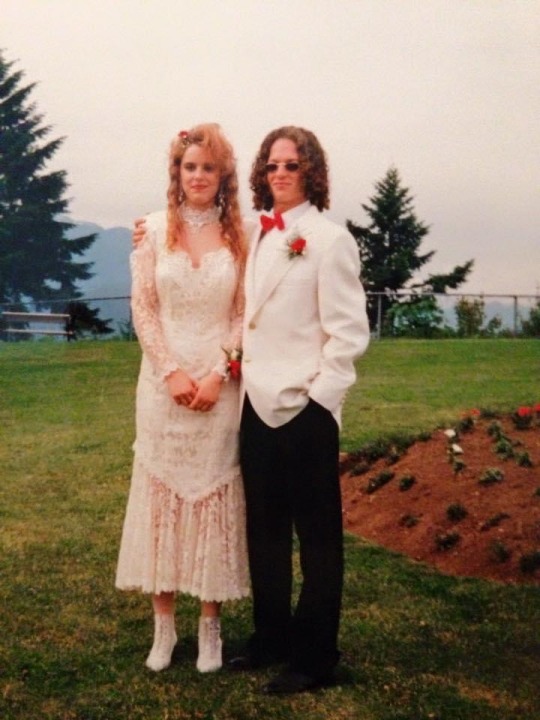
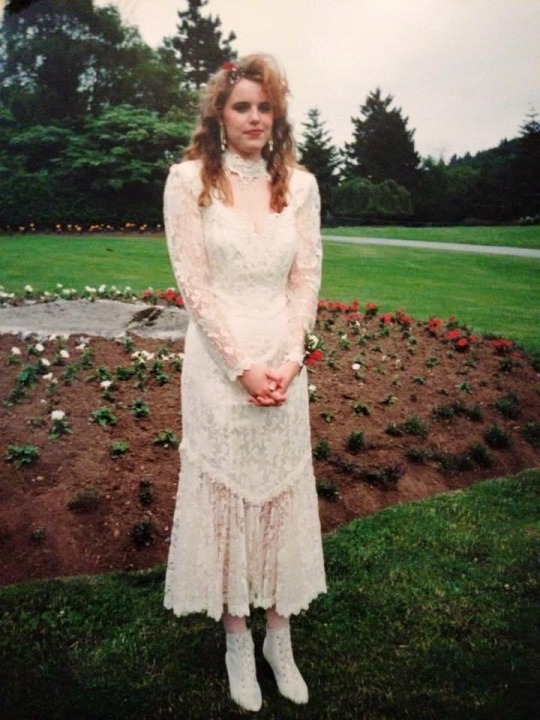
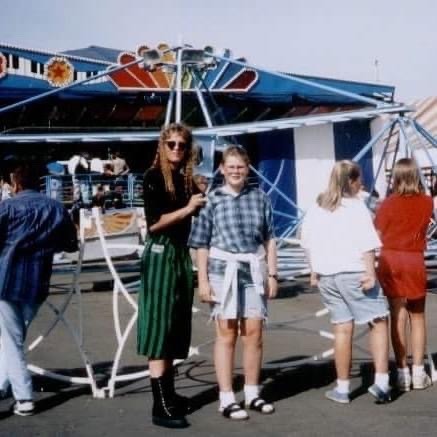
If anyone asks me what I miss the most of the 90’s it’s the music. I also loved to go to concerts. Metallica, Nine Inch Nails, Marilyn Manson (too bad he’s a gross creep now), Sepultura, Pantera, Hole, Slayer, Fear Factory, Suicidal Tendencies, Korn… The list goes on. I saw a lot of concerts then. I don’t listen to much of that kind of music, anymore. Gives me a headache. lol. Every so often I’ll throw on some grunge, though. The 70’s and 90’s were the best decades for music. I’ve been challenged on my opinion many times but my opinion still stands.
I’ll be first to admit that I still have recent fashion police problems. My Mother made me get rid of a few pairs of sweatpants which made me quite sad. Plus, I’m currently sporting blue and purple hair right now…
Sigh…
So sometimes I like to talk about random, trivial crap that doesn’t involve cancer.
Anyways, today I was offered another participant through the health coaching program. I’m not sure if I’m going to take them on. Their health history is challenging so I need more info. Man, I’m getting to the point where I should really consider reducing the volunteer work and start charging for my services. lol. Just in the past month, I’ve also had four people ask me to coach them to run a half or full marathon (one even wants to do an ultra). I’m really seeing how “doing a marathon” is turning up on everyone’s bucket list. lol. There’s a few coming up in the spring so I understand why they want to get started. The thing is, I charged really good coin when I used to coach. Sure, I’m not working now so I have time to help out but… it does take time. My time and knowledge is still valuable. I think. Anyway, I’ll see how it goes. I’m excited to just be able to talk about running so I’m happy to help. I should shut up now. I’m glad I have Tumblr as a therapist to talk this stuff out. Ha-ha.
Today I had to run some errands and help the kid with an English homework assignment including an essay. Not fun. I’m so glad I don’t homeschool anymore.
Now, I’m going to make some tea and watch Ted Lasso. I did pick up the December’s Book Club book but I think I’ll start that over the weekend.
8 notes
·
View notes
Text
Mystique and the Theories of Relativity
A little over half a year ago, I marathoned the entirety of both the 90s X-Men crossover event, Age of Apocalypse, as well as its direct prequel Legionquest in giant-sized hardcover format. One issue from the Legionquest omnibus in particular which greatly stood out to me was Theories of Relativity from X-Men Unlimited (1993) #4 by Scott Lobdell & Richard Bennett, due to how it heavily fleshes out one my personal favorite supervillain in comics, Raven Darkhölme, aka Mystique!
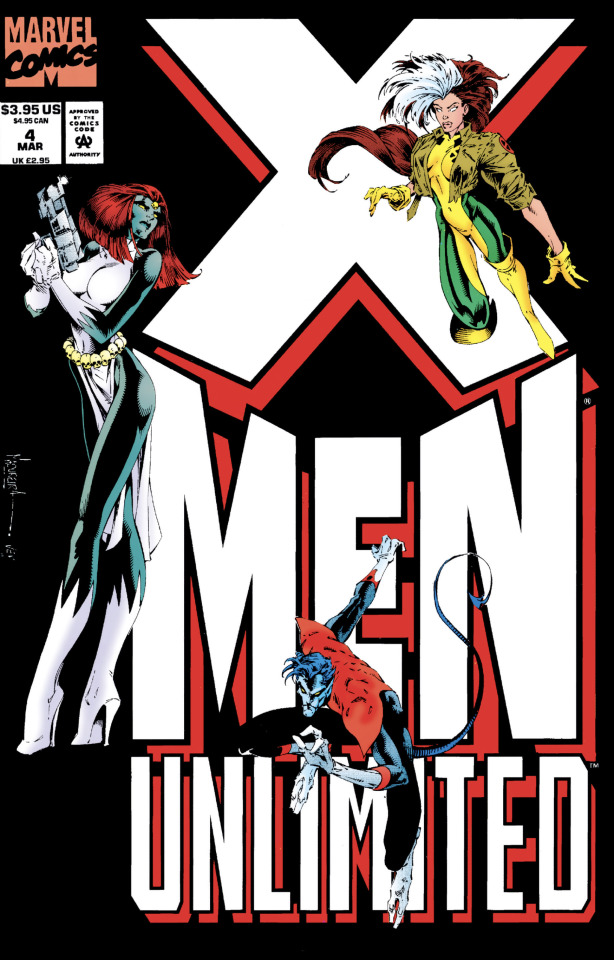
Although the 4-part Wolverine: Get Mystique arc by Jason Aaron & Ron Garney’s still stands as my personal favorite Mystique storyline, Theories of Relativity is easily a very close contender! If you want to hear more about my praise for Get Mystique, here's a link to the essay "The dualistic rivalry of Wolverine & Mystique" which I posted here a few weeks ago:
Theories of Relativity is quite notable in that it not only reveals for the first time in-continuity that the X-Men member Nightcrawler (aka, Kurt Wagner) is indeed the biological son of Mystique, but it also showcases the long-awaited family reunion between Mystique and Kurt along with the latter's adopted sister/fellow X-Man Rogue (aka, Anna Marie), and half-brother/anti-mutant bigot Graydon Creed. The issue's plot centers around Nightcrawler & Rogue investigating the assassination of a US general who sold weapons to the anti-mutant hate-group "the Friends of Humanity" and its leader Graydon Creed. They soon discover that Mystique killed the general in order to send a message that she's out for Graydon Creed’s blood after he hired his father Sabretooth (aka, Victor Creed) to assassinate Raven in a previous miniseries. Nightcrawler & Rogue are then cryptically sent to the latter's old Mississippi hometown where she was adopted by Mystique. However, the two are then intercepted by Creed who reveals that he is not only Nightcrawler's step-brother, but that they are both Mystique's biological sons. She had abandoned Creed when she discovered that he was not born as a mutant, and she threw an infant Nightcrawler off a waterfall whilst fleeing from an angry mob that perceived them both to be demons (Nightcrawler's was born with his blue-fur, while Mystique accidentally reverted back to her true appearance due to the pain of childbirth).
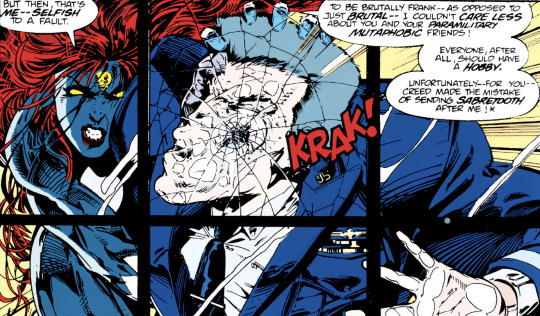


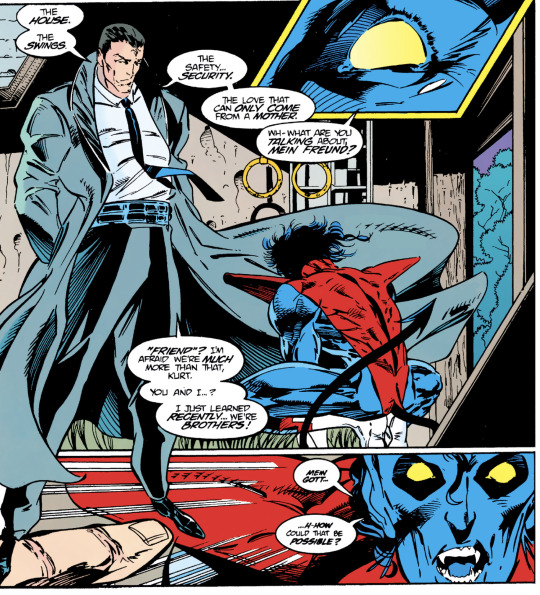
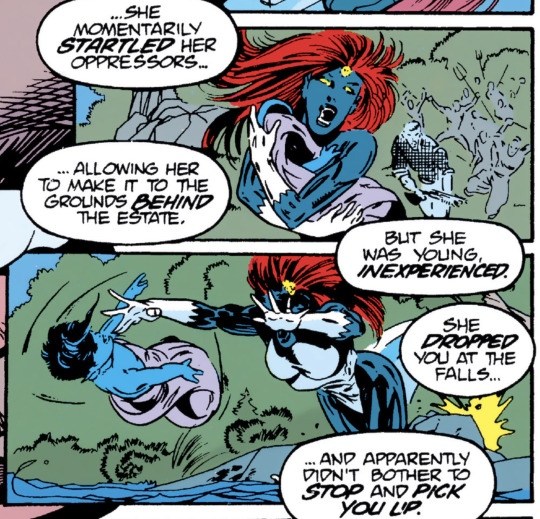
While X-Men Unlimited #4 is not a perfect issue by any means since some aspects like Mystique's foresight about Nightcrawler & Rogue specifically showing up to prevent her from killing Creed felt rather contrived, overall this was an emotionally powerful narrative which shines a spotlight on one of my favorite characters in not just the X-Men franchise, but in comic books as a whole!

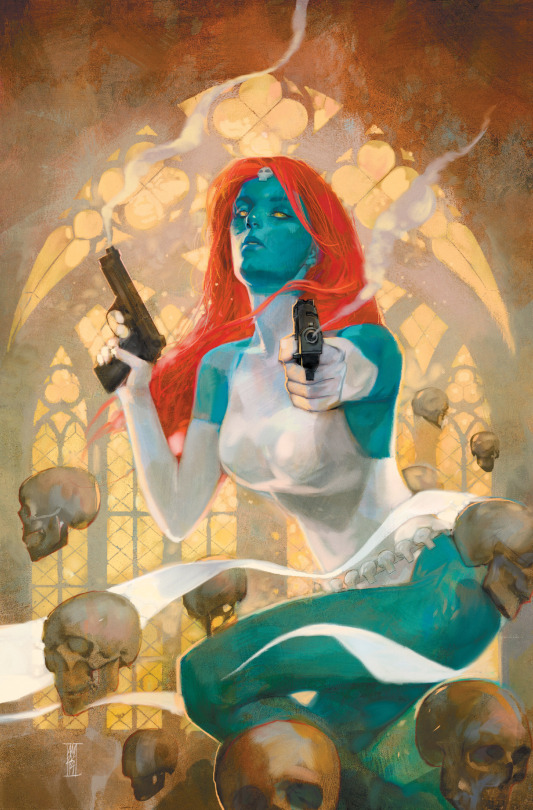
Theories of Relativity effectively illustrates what makes Mystique such a complex and multilayered villain! True to her nature as a shapeshifter, Mystique is a woman of contradictions. On the one hand she's perfectly willing to sacrifice the lives of other people if it either means preserving her own life, or if said-person fails to fulfill her own agendas. But on the other hand Raven is portrayed as being capable of showing genuine love and affection towards individuals that she see parts of herself reflected in.

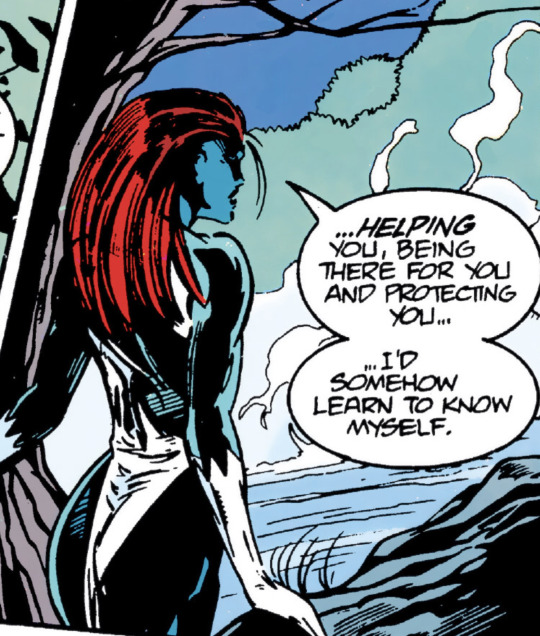
This dichotomy is most effectively demonstrated through the contrasting relationships between her two biological sons and her adoptive daughter. While Mystique expresses zero regrets regarding her cold mistreatment and abandonment of Graydon Creed & Nightcrawler, she conversely shows legitimate love towards an abandoned and orphaned Rogue, with Raven stating that she could relate to Rogue’s inability to physically touch others due to her own history of utilizing her shape-shifting powers to prevent others from touching her. Raven even goes as far as to claim states that both Rogue and her then-late wife Destiny (aka, Irene Adler) were the only people she ever felt genuine feelings for.
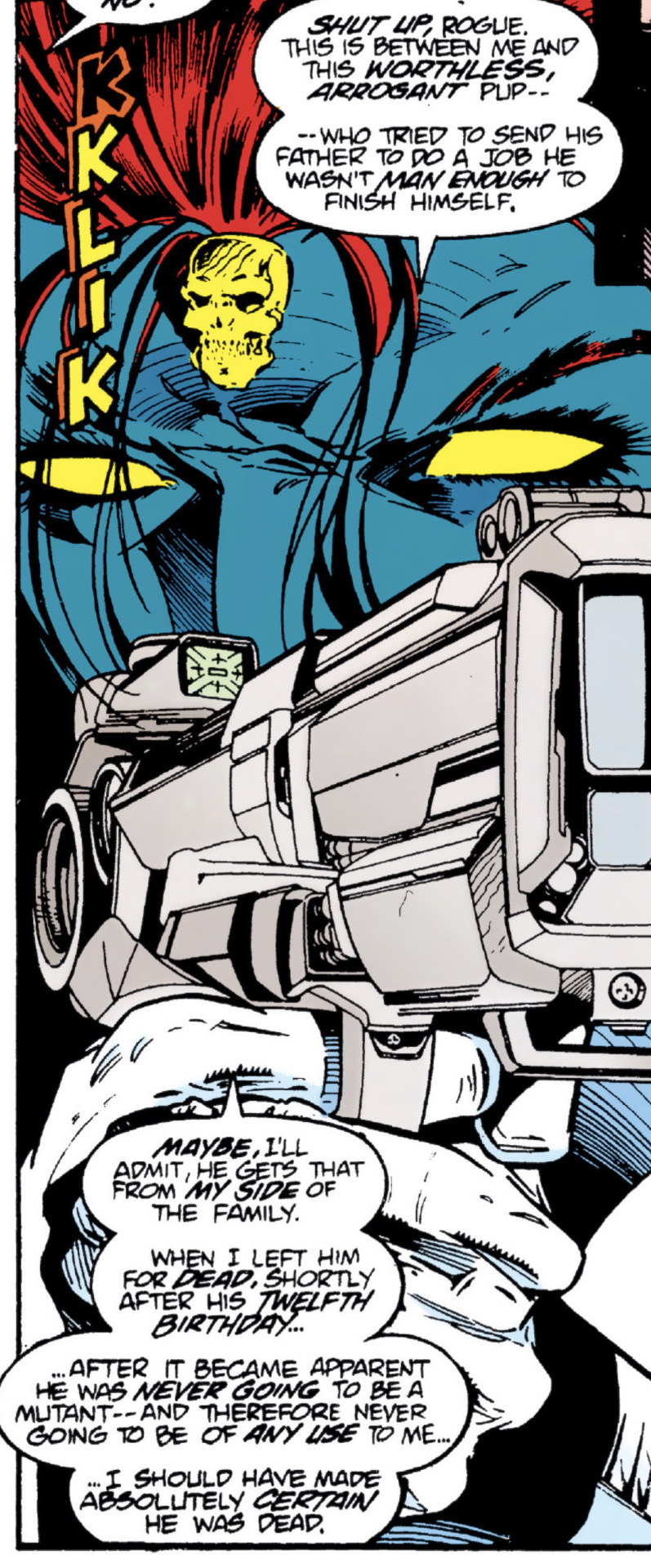

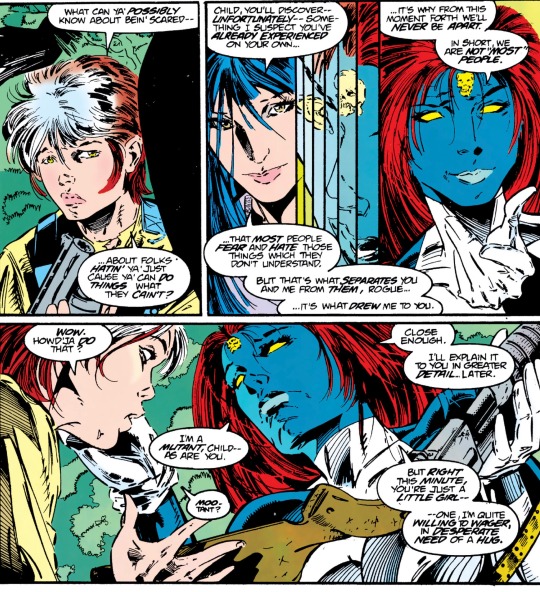

These conflicting aspects of Mystique’s personality are elements of the character which have always made her such a nuanced and compelling villain to me. Elements which have carried over into the modern era, such as with Wolverine: Get Mystique emphasizing Raven's duplicity and willingness to unashamedly sacrifice others in order to fulfill her own interests, while it’s direct prequel X-Men: Messiah Complex emphasized said-villainous traits as simultaneously being derived from Mystique's selective love for individuals like Rogue & Destiny.
In a broad sense, one could interpret Mystique’s hardened exterior and boastful pride of seemingly only caring about for herself as yet just another contradictory facade. A metaphorical form of shape-shifting that Raven's developed over the past century she's been alive for as a self-preservation mechanism which allows her to prevent others from hurting her, consequently hiding elements of her true self from the rest of the world in the process.
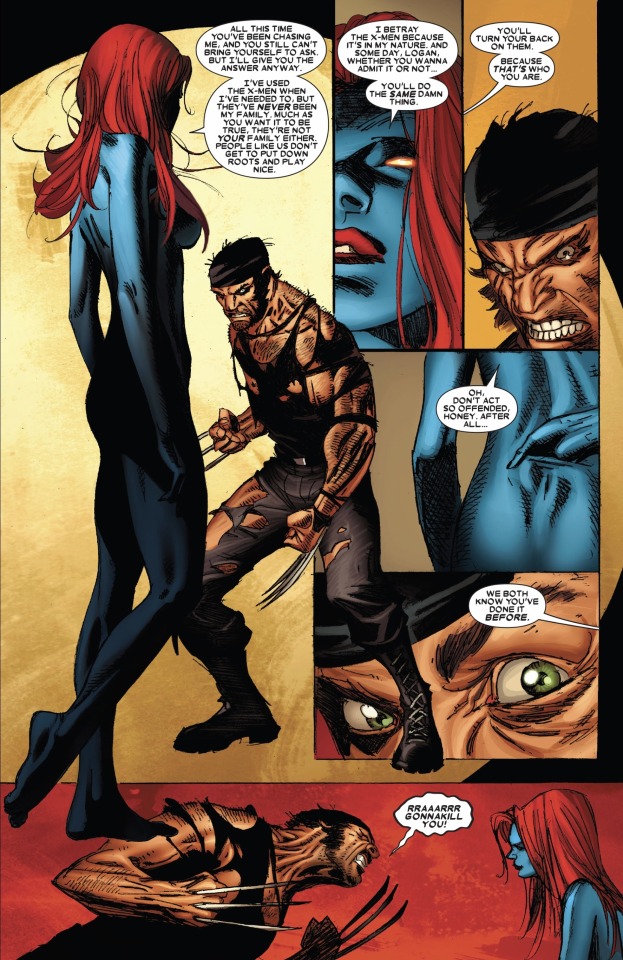
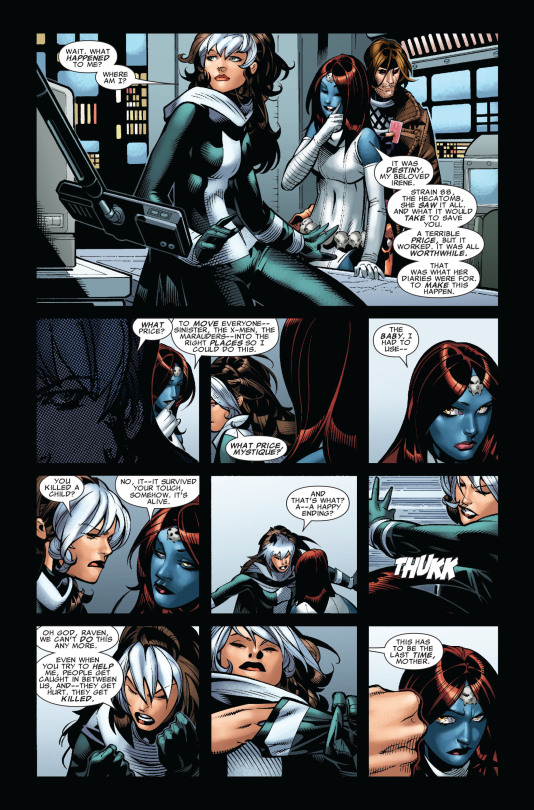

This is an interpretation which Theories of Relativity supports through its climax, wherein Mystique surprisingly sacrifices herself so that Rogue can save Nightcrawler from death despite referring to her son as "unwanted" earlier in the issue. Yet another contradiction in Mystique's facade, one which heavily reminded me of the plot twist from the Wolverine Goes To Hell storyline wherein Raven betrayed the Red Right Hand after helping them banish Logan's soul to Hell upon discovering the organization's plans to manipulate Wolverine into unknowingly slaughtering his own children. And Raven did this simply out of respect Logan's friendship for her then-deceased son Nightcrawler, putting aside her own selfish hatred for the sake of someone she genuinely loved.
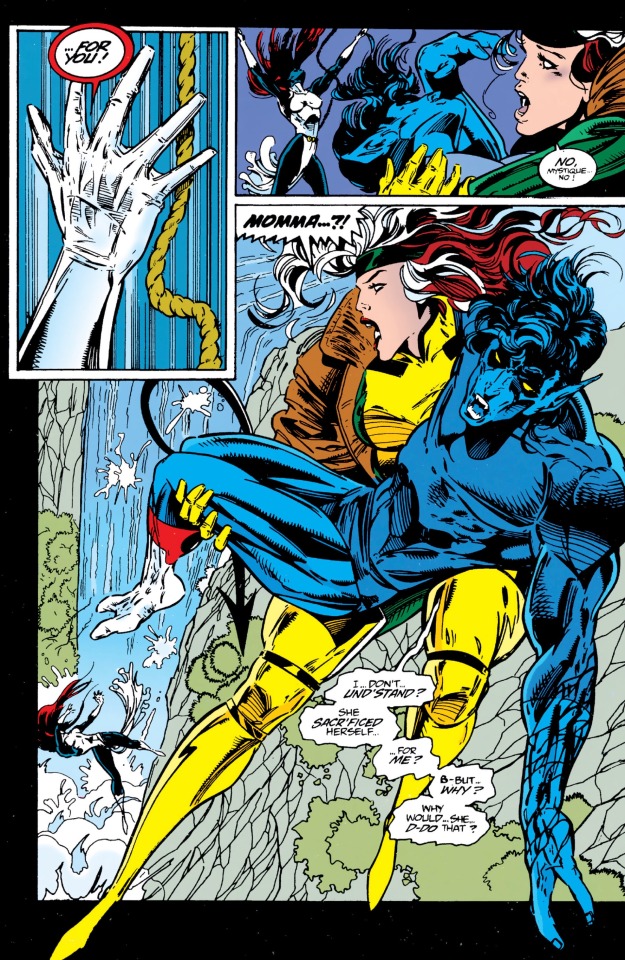
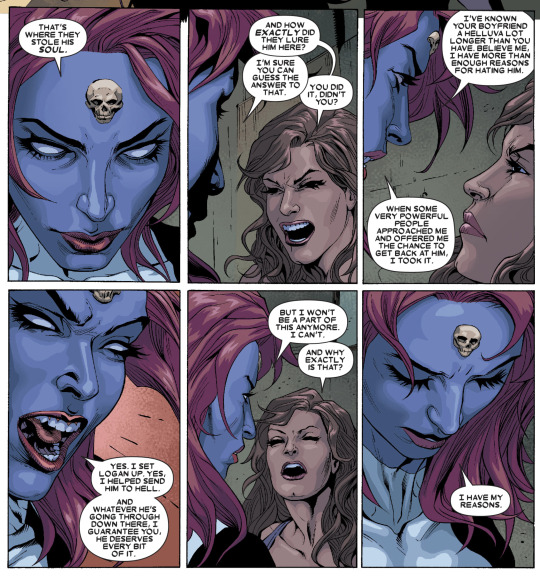

Overall, X-Men Unlimited #4 is a prime testament to what makes Mystique one of my all-time favorite comic book villains. Additionally, there's a lot of fascinating queer themes which the reader can derive from this issue. These can include themes found-family through Rogue & Mystique's relationship, as well as Graydon Creed's status as a normal human who hates his two mutant parents being reflective of real-life instances of familial rejection occurring between cis-het adults and their queer parents.

The latter example is a theme which transgender YouTuber Vera Wylde from Council of Geeks mentioned in her brilliant "Mystique - Queer Icon!" video:
youtube
Plus, the issue also contains some truly hilarious scenes like Mystique shape-shifting into Abraham Lincoln whilst calling out the U.S. general's dishonesty before assassinating him!
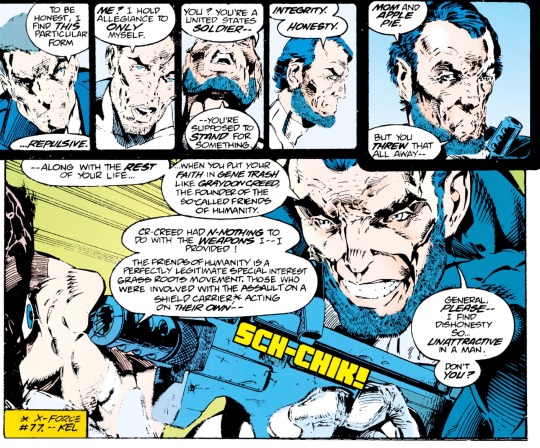
And as a fun bit of trivia, I love how the dust-jacket of the Legionquest Omnibus which reprints this issue also refers to Destiny being as Mystique's "lover," even though this story came out in the 90s before it was confirmed that the two were a lesbian couple!

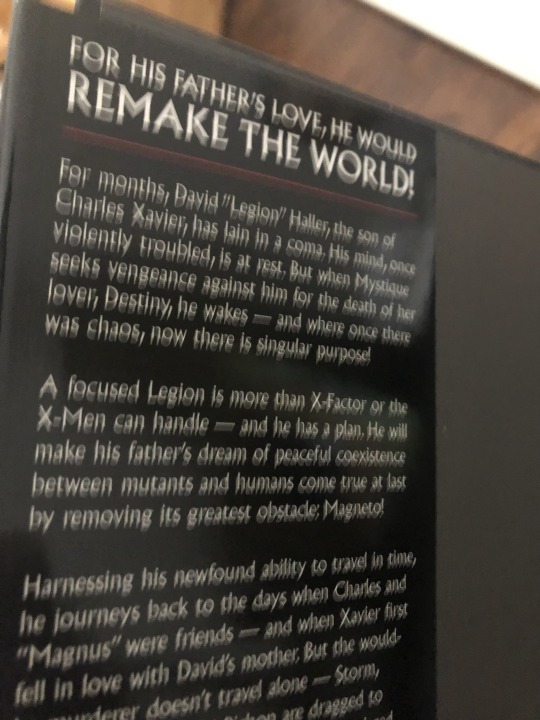
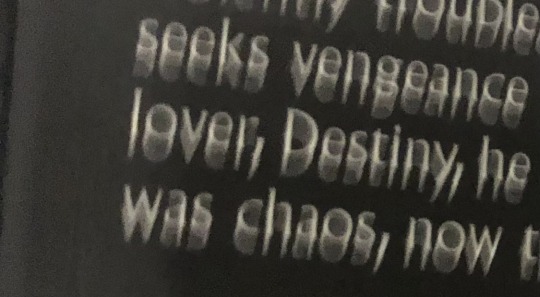
But yeah, overall, Lobdell & Bennett's work on X-Men Unlimited #4 definitely ranks highly among the quintessential Mystique stories IMO!
#mystique#raven darkholme#x-men unlimited#theories of relativity#get mystique#wolverine goes to hell#messiah complex#nightcrawler#kurt wagner#rogue#anna marie#graydon creed#destiny#irene adler#lgbtq#scott lobdell#richard bennett#jason aaron#ron garney#mini essay#marvel comics#90s comics#vera wylde#council of geeks#Youtube
20 notes
·
View notes